Alpine marmots are typical animals of the European Alps and popular among many hikers. I have seen alpine marmots close to the Königsbachalm in the Berchtesgadener Land in Bavaria in one summer. In this blog entry I will tell you more about my encounter with them and the alpine marmots as a species itself.
Are there alpine marmots on the Königsbachalm?
"I have never seen an alpine marmot on the Königsbachalm", said the receptionist at the youth hostel in Berchtesgarden.
"What??????", I asked myself in silence. The receptionist immediately saw my disbelief in my wide open eyes and added straightaway:
"But my friend saw apparently quite many of them there."
I was relieved. "The whole journey to the Berchtesgadener Land to find alpine marmots was not in vain", I thought.
"You just have to get up very early in the morning like my friend in order to find them. Probably at 5 a.m. or so", continued the receptionist.
She then gave me some further information about the exact location of the Königsbachalm, a timetable of the buses and the opening hours of the Jennerbahn (the gondola lift) which connects the lowland with the Jenner mountain.

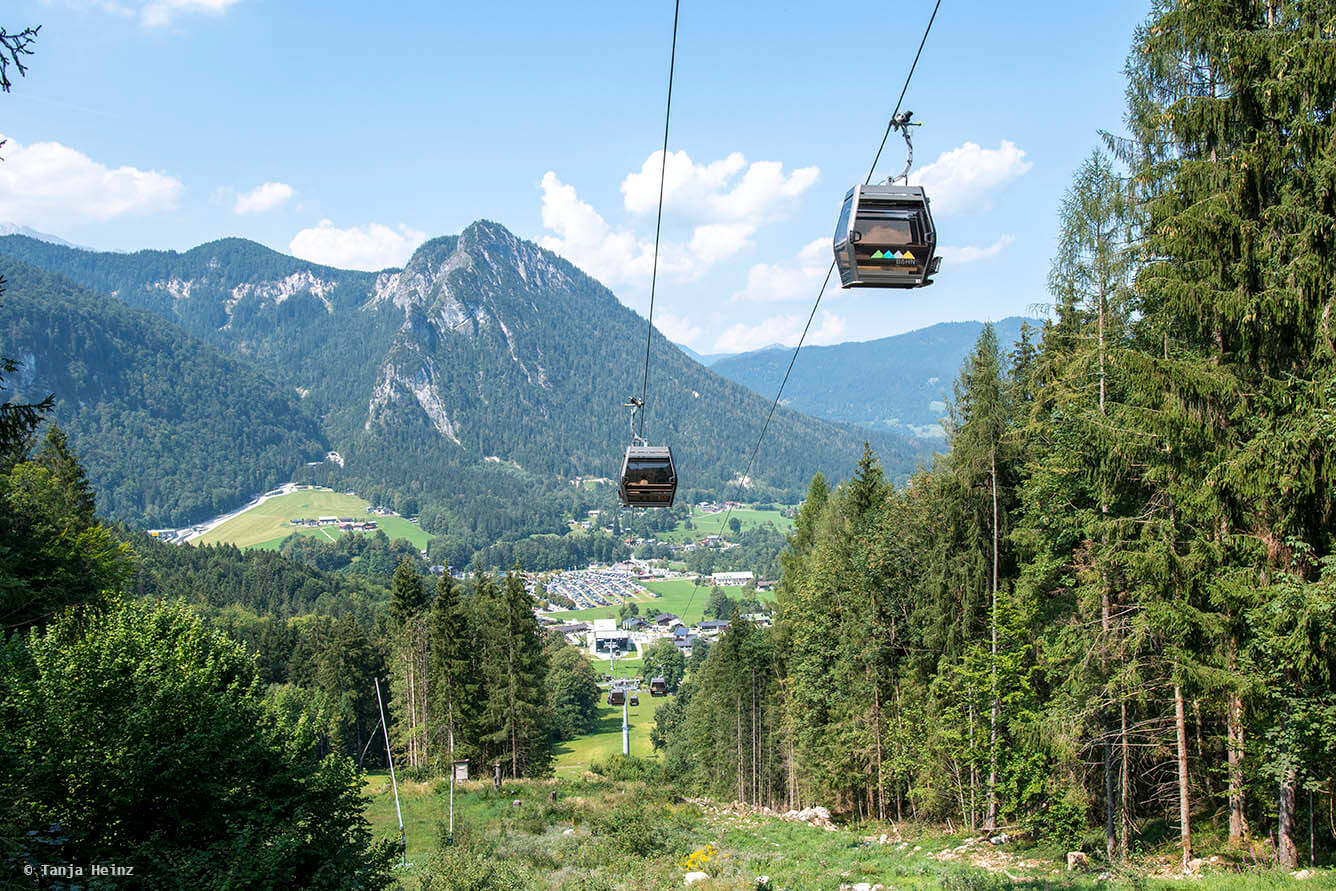
Unfortunately, there was neither a bus to the Jennerbahn nor a connection between the lowland and the mountain at the specific time I wanted to leave.
"Well, then I have to walk from the youth hostel to the Königsbachalm", passed through my mind. I started to calculate the hours I would need for my hike. For a distance of about five to six kilometers from the youth hostel to the Jennerbahn I would probably need about an hour. And as Google told me that the walk from the Jennerbahn to the Königsbachalm would take no longer than one hour and a half, I assumed to need more or less two hours and a half from the youth hostel to the Königsbachalm. "All that is no problem for an early bird like me", I thought. My aim was consequently to get up at 3 a.m. in the night to be on the Königsbachalm at 6 a.m. to observe alpine marmots.
Tip: If you have a car, you can also leave your car at the parking place Hinterbrand (German: "Hinterbrand Parkplatz") from where you can hike to the Königsbachalm. The address of the parking place is Scharitzkehlstraße 40, 83471 Schönau am Königssee.
As I was not that convinced about my plan - and I have to admit that I was also a little bit scared by the thought to walk alone up to the Königsbachalm in the darkness... - I went to the local tourist information center to hopefully get further information about the alpine marmots on the Königsbachalm and a possible hiking path.
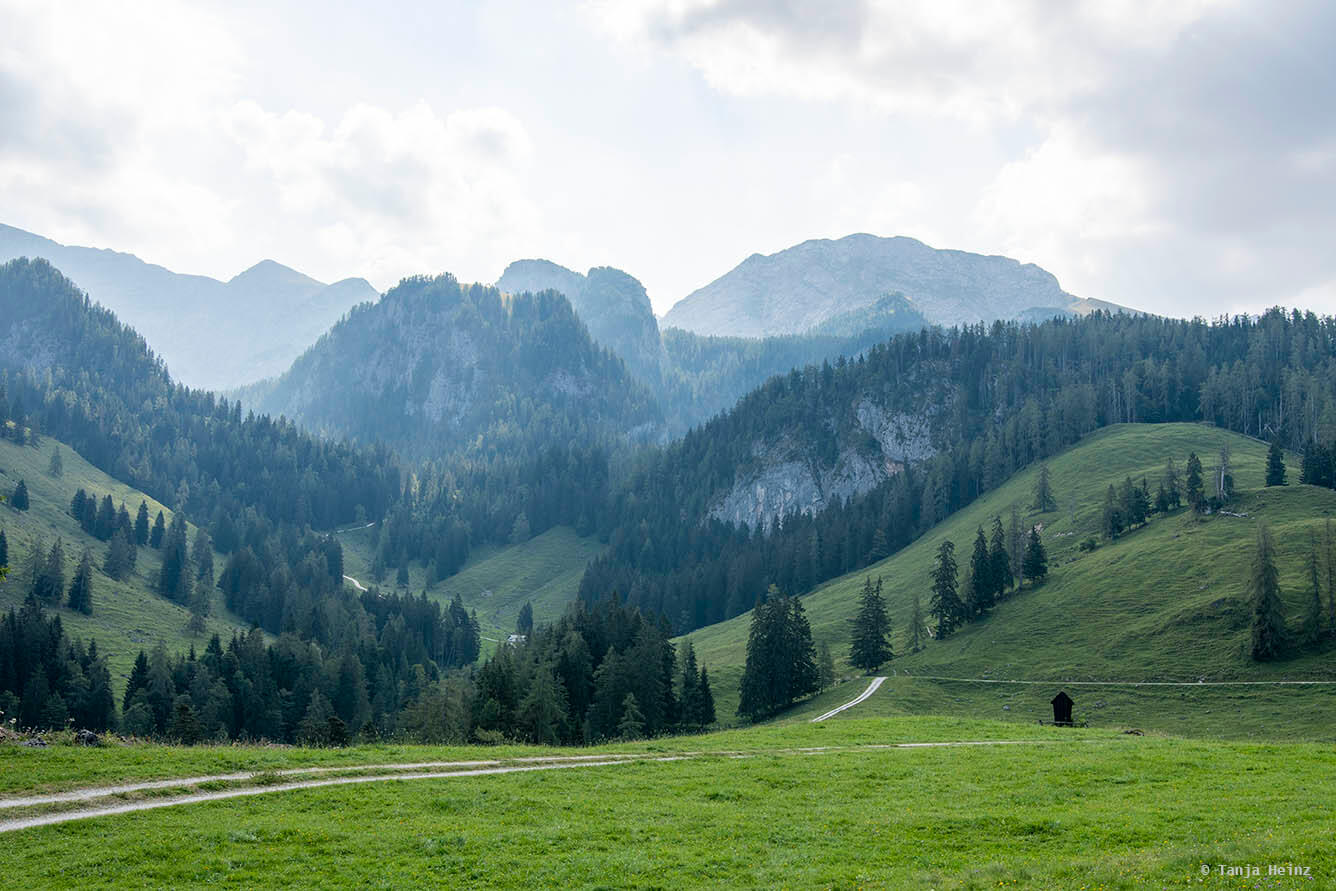
"Yes. There are alpine marmots on the Königsbachalm, but you have to be there early in the morning, as they will go back into their burrows when it is getting hot. Furthermore, the alpine marmots are shy animals and they will hide from hikers. Early in the morning the chances to see them are much better, as there are only few hikers around the Königsbachalm", was the answer to my questions.
Ok. I understood. There was no other feasible option for me in the Berchtesgadener Land to observe alpine marmots in the wild. I had to get up early (very early!) in order to see alpine marmots on the Königsbachalm in the Berchtesgadener Land...
Tip: If you decide to walk from Berchtesgaden to the Jennerbahn at night, I recommend you to find the right way out of town a day before if you do not know the location. I was so glad that I did that. This way I saved some time, because I did not get lost.
Alpine marmots in the Berchtesgadener Land
All this might sound crazy for some people. Walking up the Jenner in the darkness. Leaving in the middle of the night at 3 a.m. just to be on the mountain on time when the alpine marmots get out of their burrows in the morning.
At the end it was not crazy at all! Yes, I was a little bit scared walking alone through Berchtesgaden and up the mountain to the Königsbachalm when it was still dark. But I was rewarded with some great marmot watching experiences. I also had to wait patiently a little bit, and furthermore, needed some luck. But at the end I got to see some of them in the wonderful Berchtesgadener Land.
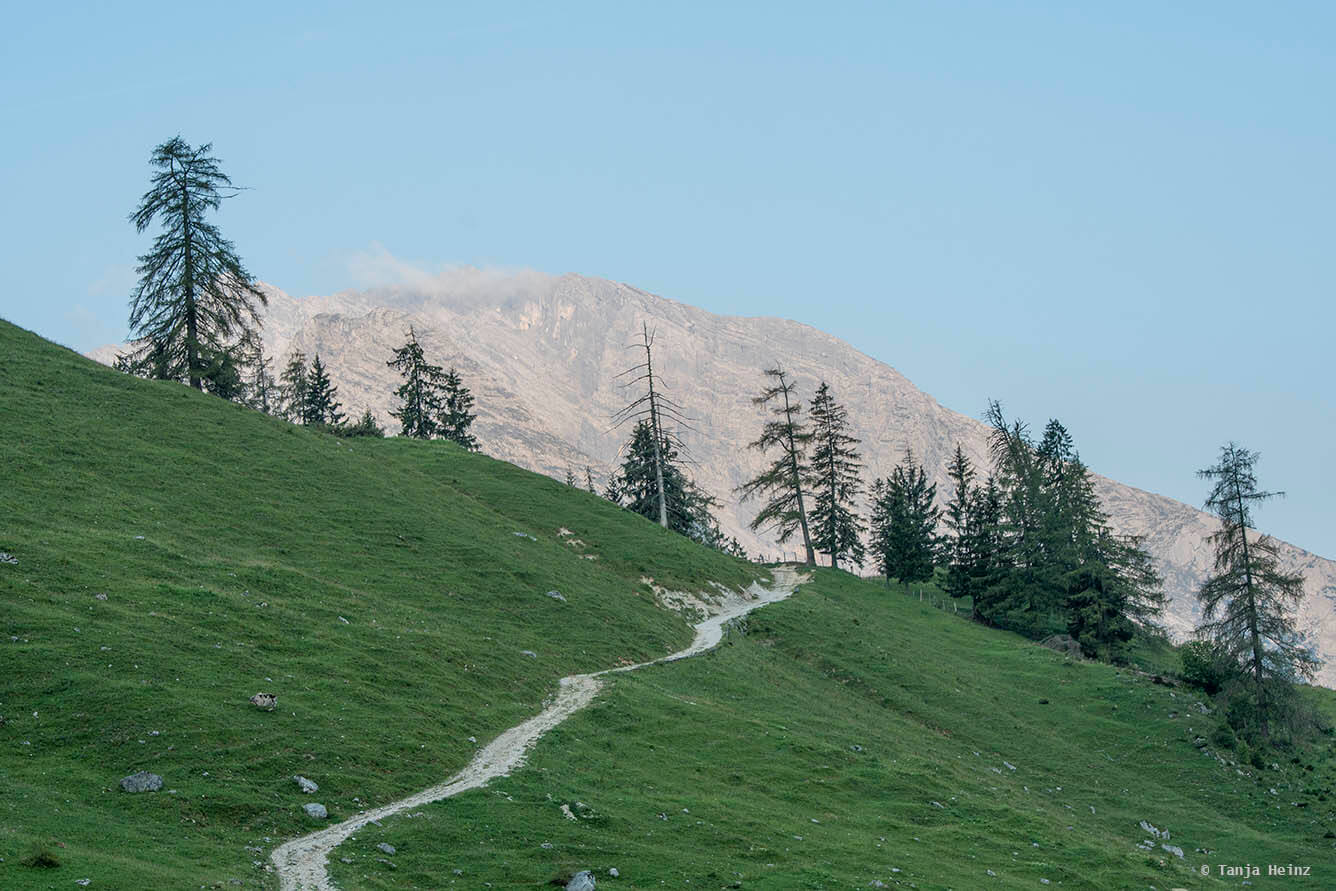
When I arrived at the Königsbachalm I checked my watch. It was exactly 6:07 a.m. The path up the mountain was tougher than I had thought. I was walking more than one hour and a half up the mountain without any break. When I reached the Königsbachalm, first of all I had to rest a little bit. I sat down on a stone. I was all by myself. No hikers. No cyclists. And no person at the Königsbachalm was around. I enjoyed the silence, the beauty of the mountains, and all the look-outs I got. "But well, where are the alpine marmots now?", I asked myself when I felt ready for some wildlife observations.
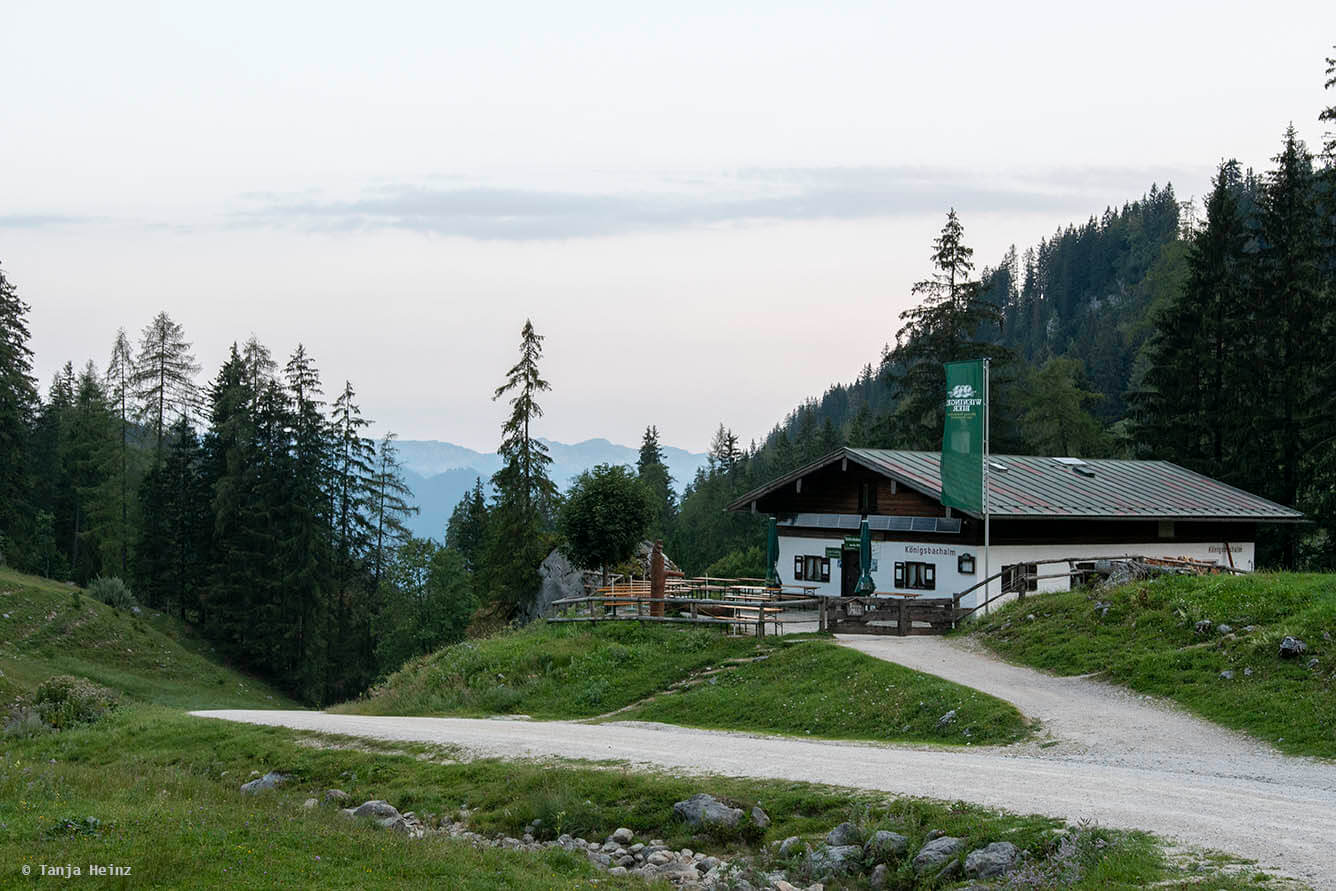
Although I was just next to the Königsbachalm, there was no evidence of any alpine marmot around. Neither animals sneaking from one hole to the next. Nor any indications of their burrows.
I did not know where to look for the alpine marmots around the Königsbachalm. And it was absolutely quiet. No movements. No calls. Nothing.
I sat on a stone and waited. And waited. And waited... After an hour I was a little bit worried. "Where are they?", I asked myself again and again. "Everyone says that the alpine marmots live around the Königsbachalm and that they are most active in the morning?!"
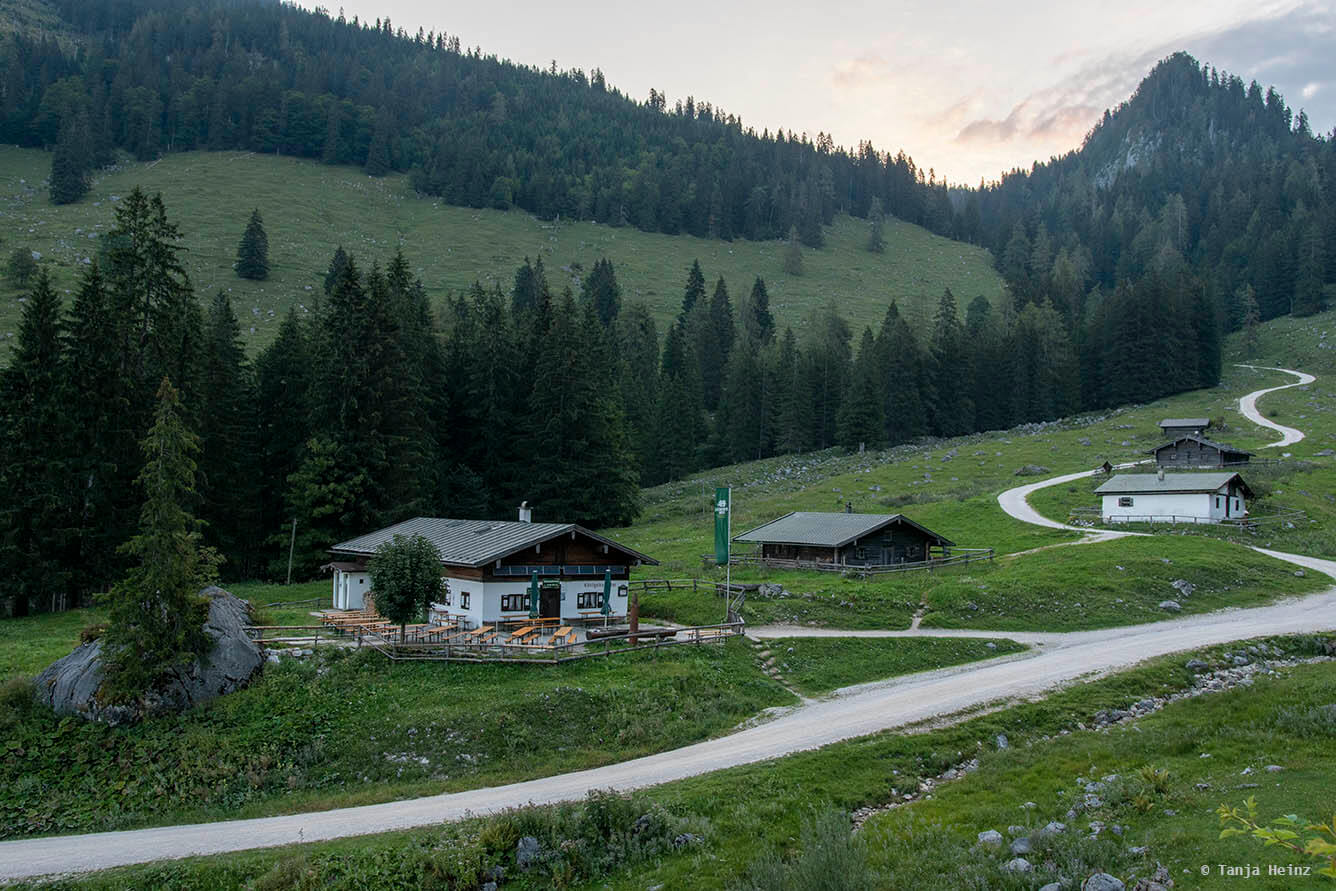
There was absolutely no alpine marmot around. I even couldn’t ask anyone for information. The Königsbachalm was closed and no other local hiker stopped nearby. I just saw some cyclists passing the Königsbachalm. As I didn’t want to stop the cyclists in the middle of their exercises, I couldn't ask them for the alpine marmots. And maybe they wouldn’t have known it anyway, as they were probably mostly interested in doing sports than in wild animals.
Tip: I visited the Berchtesgadener Land on a summer day in August, but the Königsbachalm was closed. I couldn’t find out their opening hours. If you want to know more about the Königsbachalm, you might be interested in visiting the following website.
However, there was one cyclist who stopped just next to me. I saw his tripod and camera and knew immediately that he most probably had more information about the alpine marmots around. And Indeed. He did. He knew where to find them. He told me that there were no marmots around the Königsbachalm, but I had to walk a little bit farther pointing into the direction of the next fork in the path which would lead me to the next alp (German: "Alm"). This information really helped me!
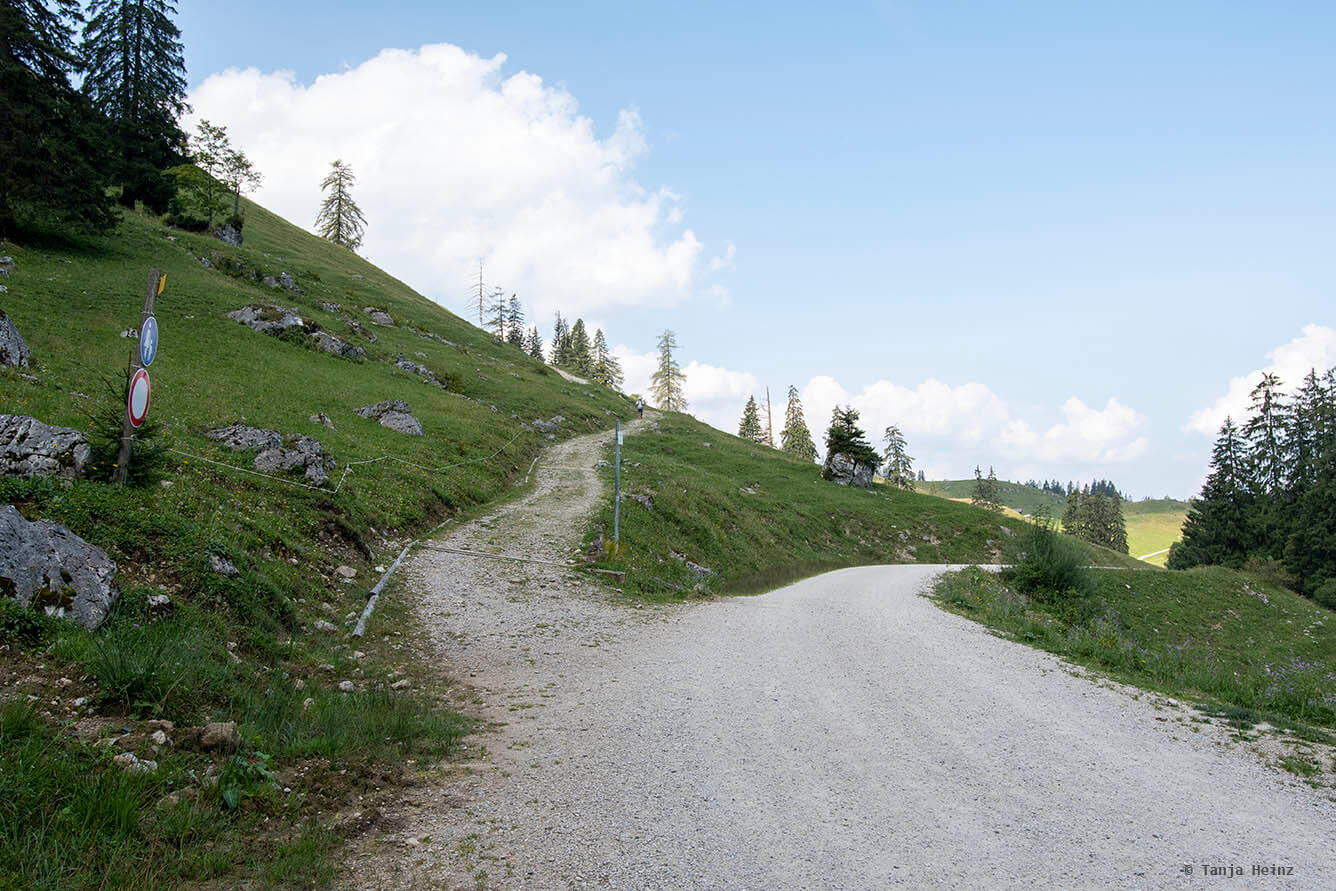

He was on his way to make new contacts with people who know more about the blackcocks (Lyrurus tetri) in the Berchtesgadener Land, as he wanted to photograph them. He knew already the alpine marmots here and had photographed them several time. But today he was on another mission. So he left again and I was heading to the marmots.
And there... an alpine marmot was sunbathing (at least it looked like that) just in front of its burrow.

As I didn’t know their flight initiation distance, I tried to be as invisible as possible. With my rucksack on the back and my camera in my hands I anyhow tried to approach a little bit more. In vain. The alpine marmot drew back and vanished in its burrow.
Well, maybe this was not that smart. I should have been more cautious. So I sat down on the ground and waited. And waited... and waited... by looking at the burrow. But instead of an alpine marmot I saw this other man, who helped me to find the alpine marmots, again. He was talking with the farmer of the alp.

Later he told me, that he had changed his mind.
Nevertheless, I was sitting close to several burrows in the hope of seeing any alpine marmot. Sometimes an alpine marmot was brave enough to take a look at the outside.


Important! Please do not feed the alpine marmots in order to get them out of their burrows. They are wild animals and not used to be fed by passing hikers. Keep a distance and just wait! Be patient and be prepared for some beautiful observations.
Photographing alpine marmots was by all means not an easy task. I observed the other man and thought that he probably had more luck with them.
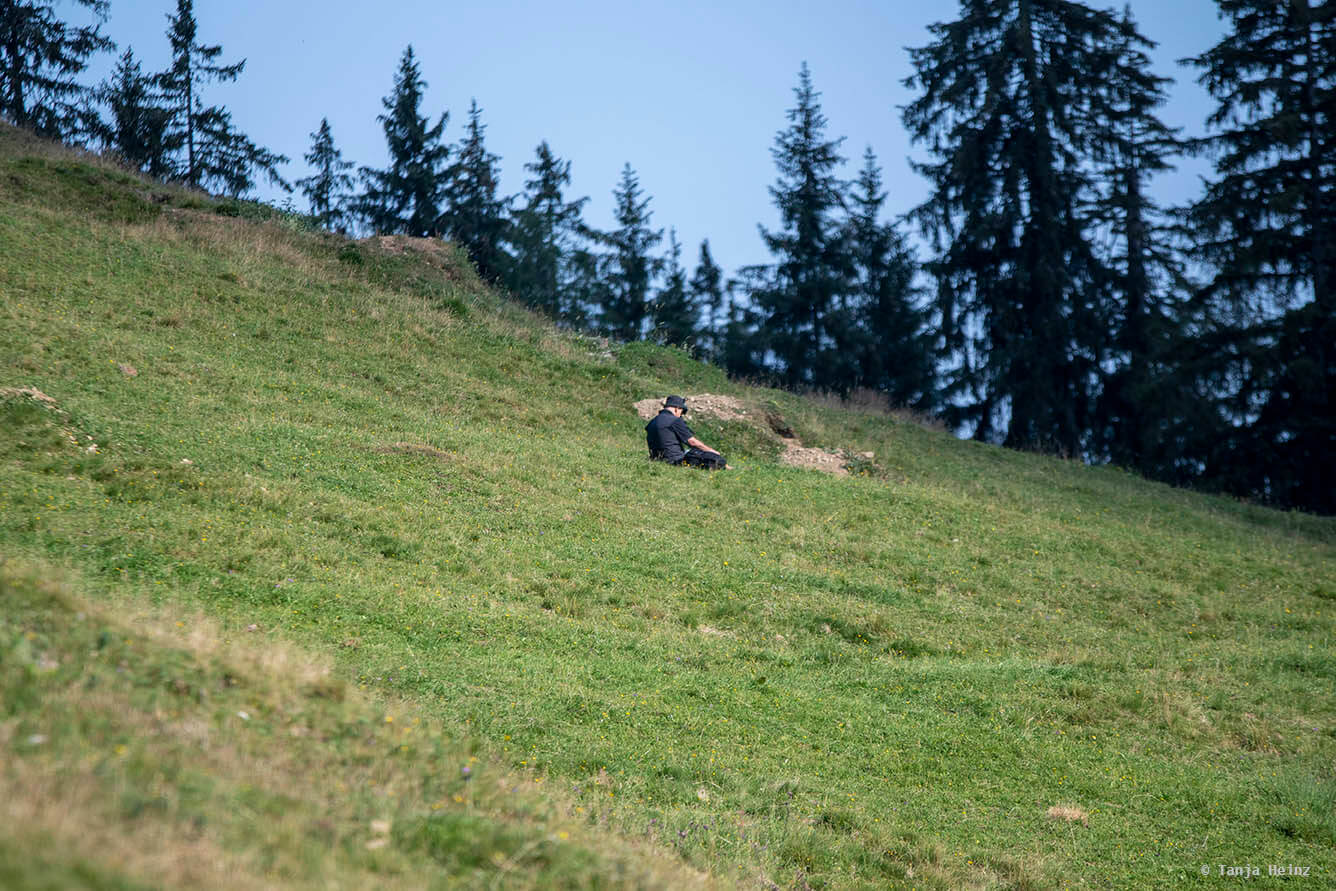
No. On that day he was neither successful in photographing nor filming the alpine marmots. But he was very surprised about this. Normally the alpine marmots around the alp are active early in the morning and they draw back to their burrows later on the day. But on that day everything was apparently different. As it was for me the first time there, I could not compare my photographing experience on that day to another day. Due to the alpine marmots‘ shy behavior on that morning, he decided to leave. He had no explanation why the animals didn’t leave their burrows. So he left. And I stayed.
Tip: If you are interested in photographing alpine marmots, remember to take lenses with a long focal length. Due to the great flight initiation distance and as you should keep in general a distance to wild animals, you cannot approach alpine marmots to take close-ups without lenses with a long focal length.
I still hoped to see a little bit more of them. So I sat down on the meadow again and waited.
Anyhow, just shortly after his leaving, the alpine marmots became braver and I observed more and more animals looking out of its burrows. And especially, apparently they were not that wary anymore.

Awwww... I was so excited! Alpine marmots are wonderful animals! But despite my excitement, I had to be very careful with my movements. One false move would have caused the alpine marmots to flee. Thus, I had to control very well my enthusiasm. Even when I tried to crawl to another place to observe an alpine marmot from a different perspective, often the animals drew back.

Thus, I had to accept it. I had to accept their flee initiation distance and remain on the place were I was.
When I was looking around I saw several alpine marmots venturing outside.
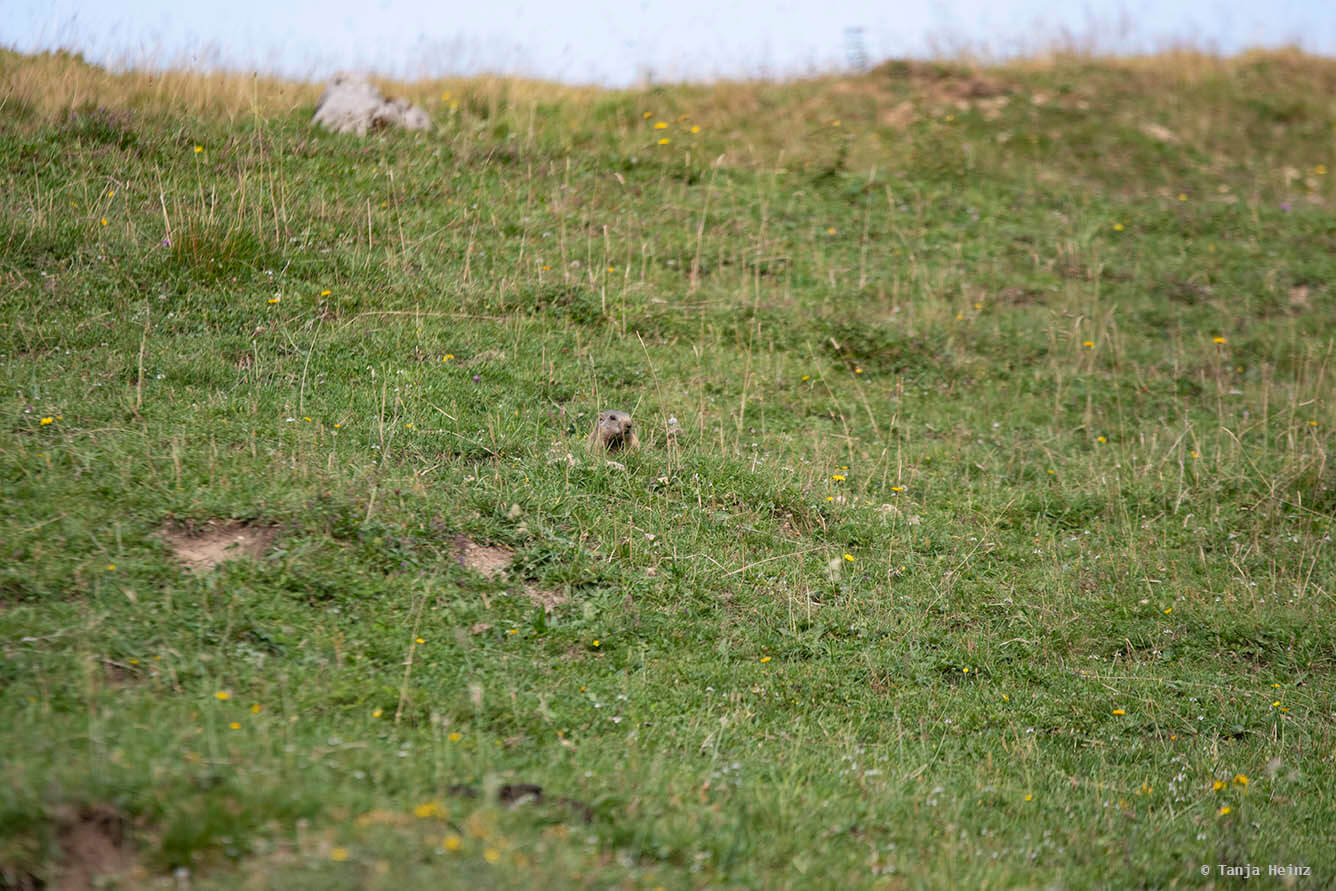
It was especially rewarding when an alpine marmot completely left its burrow.
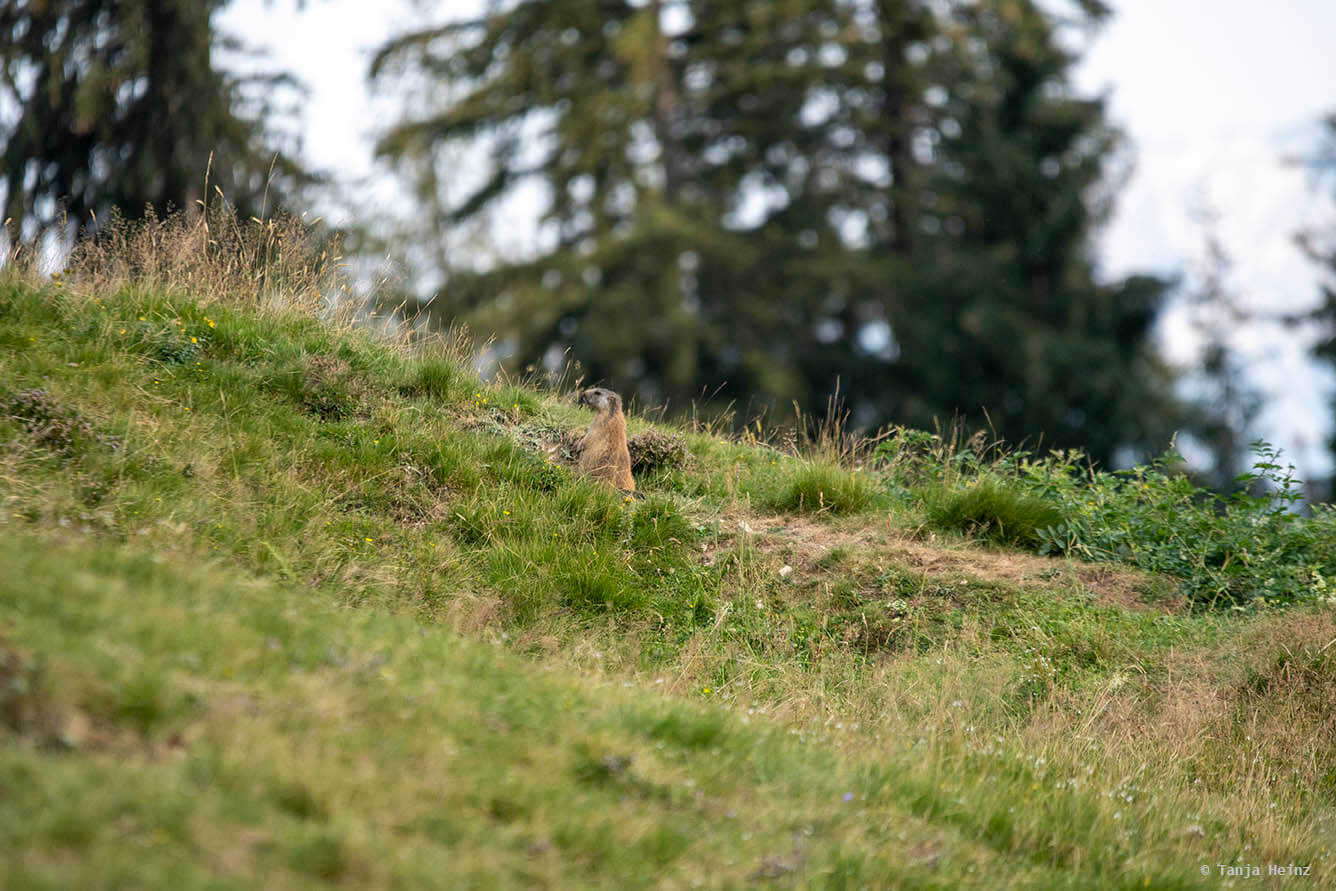
Although I was very excited and so thrilled about these alpine marmots, I had to force myself to remain seated. Luckily, my patience was promptly rewarded. Just shortly after my first good observations one alpine marmot got out of its burrow to sit on the top of its burrow. It was so close and apparently didn’t care much about my presence.
Finally, I could take some nice photographs of one alpine marmot.

That time I did not have to force myself to remain seated. Everything was already just perfect. Me and this alpine marmot anywhere in the Berchtesgadener Land.
But as time passed more alpine marmots became adventurous. Therefore, I decided to changed my position in order to hopefully see even more of their behavior. When I left, the other alpine marmot became a little bit wary of my change of position.
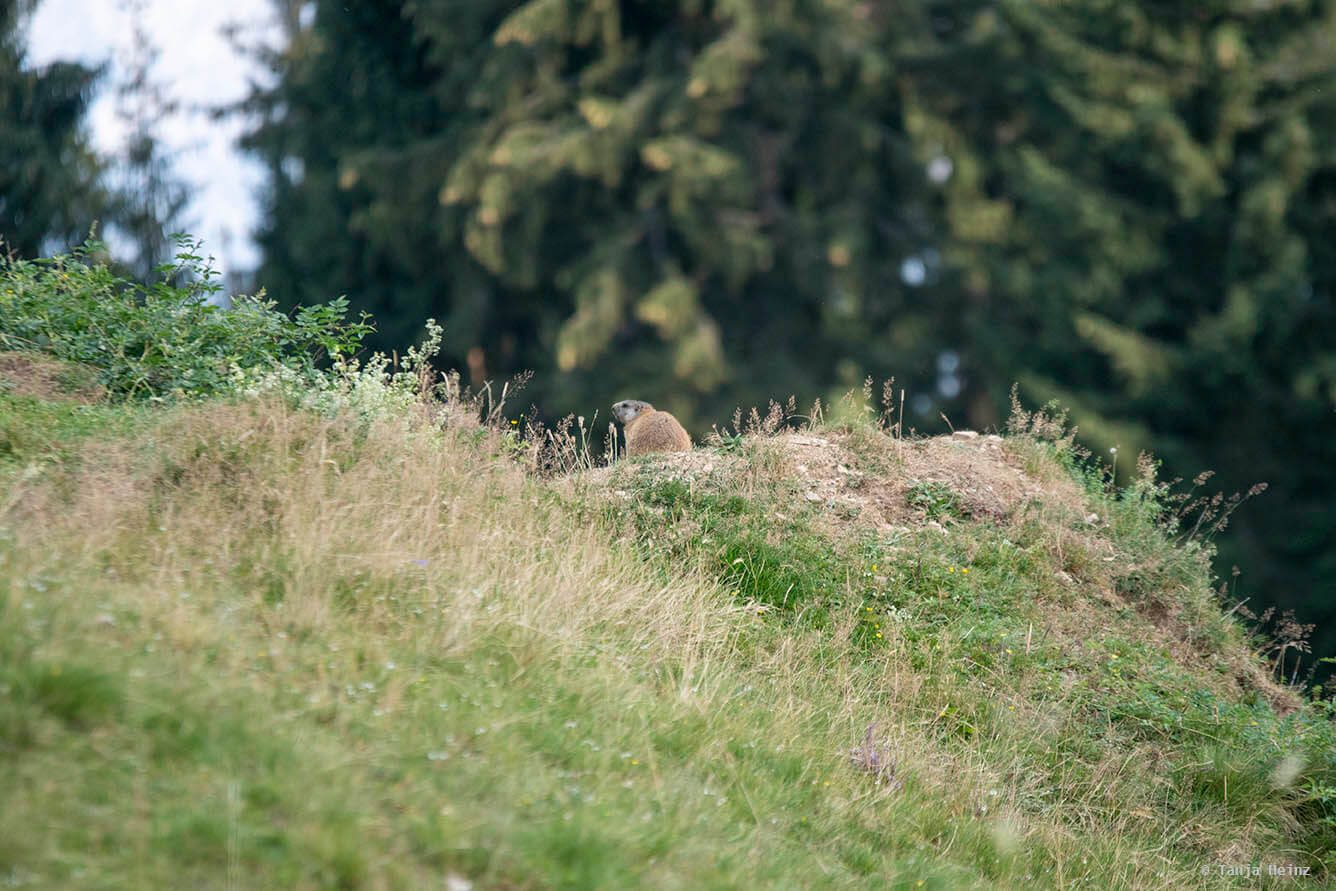
I had to be very careful in order to not chase them away.
Luckily, they were obviously not that scared by my presence and some other individuals also left their burrows.
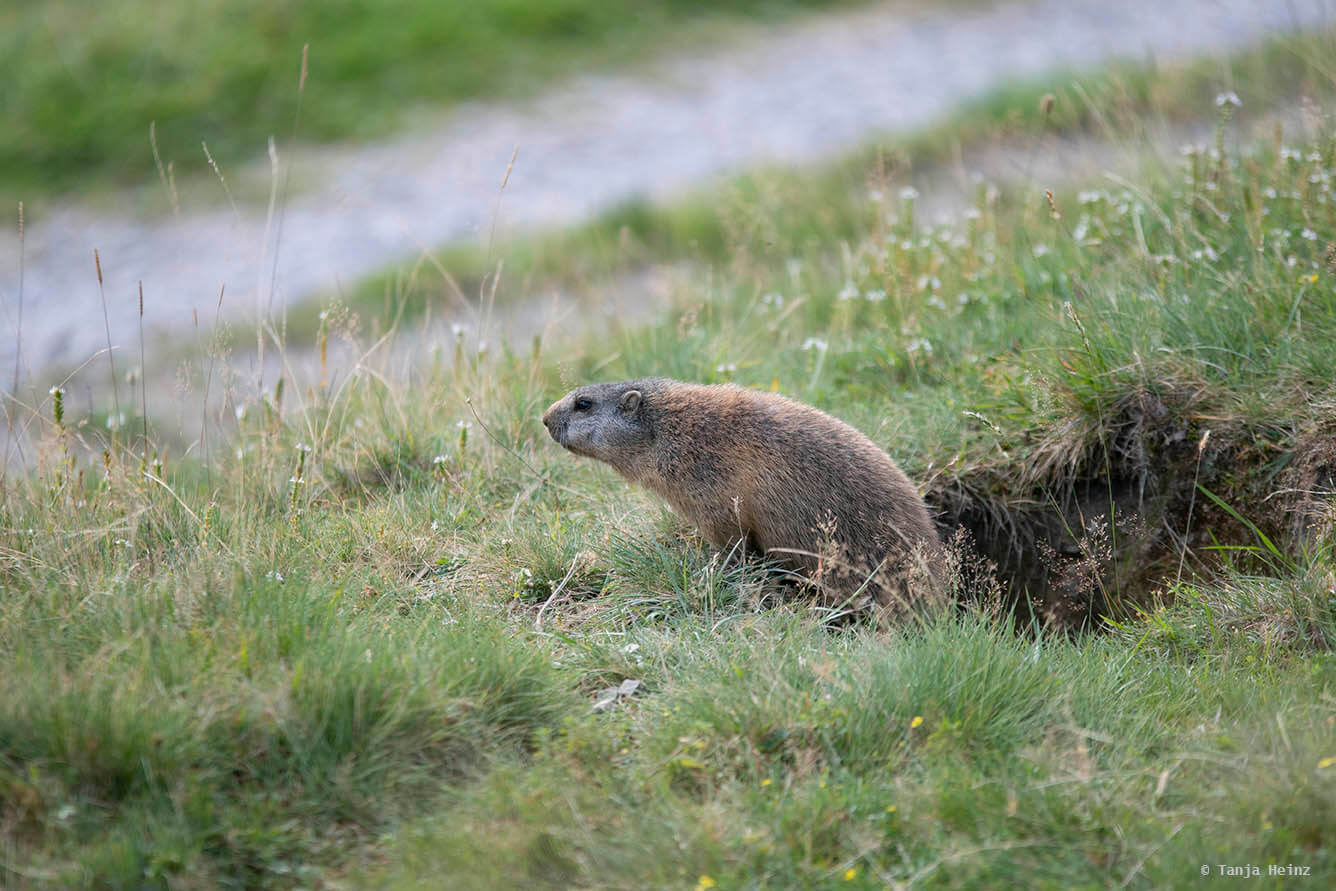
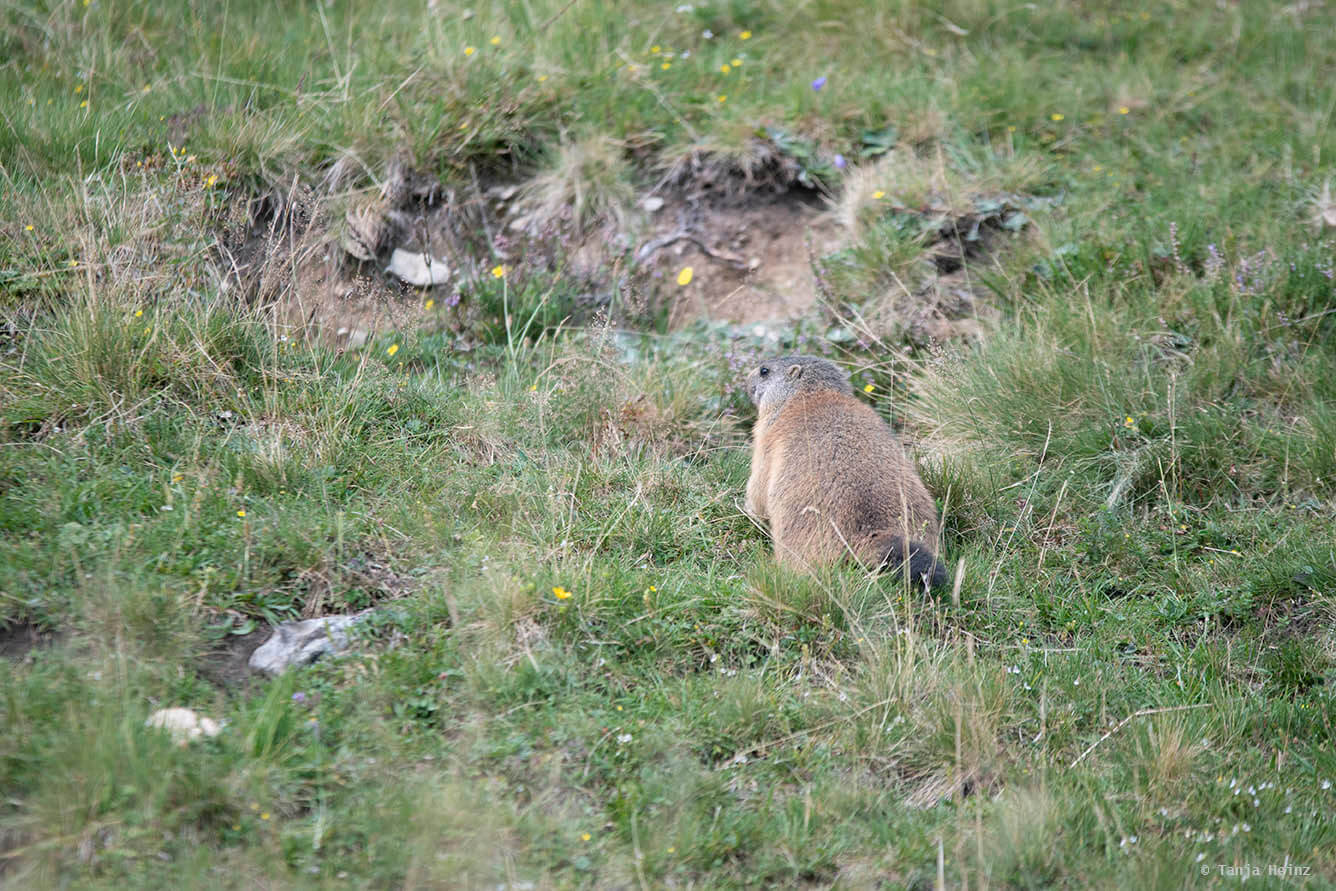
Why have they been so wary early that morning? On that morning the alpine marmots were most active around 10 a.m. As it was a hot day and the sun was shining, I was very surprised about their behavior.
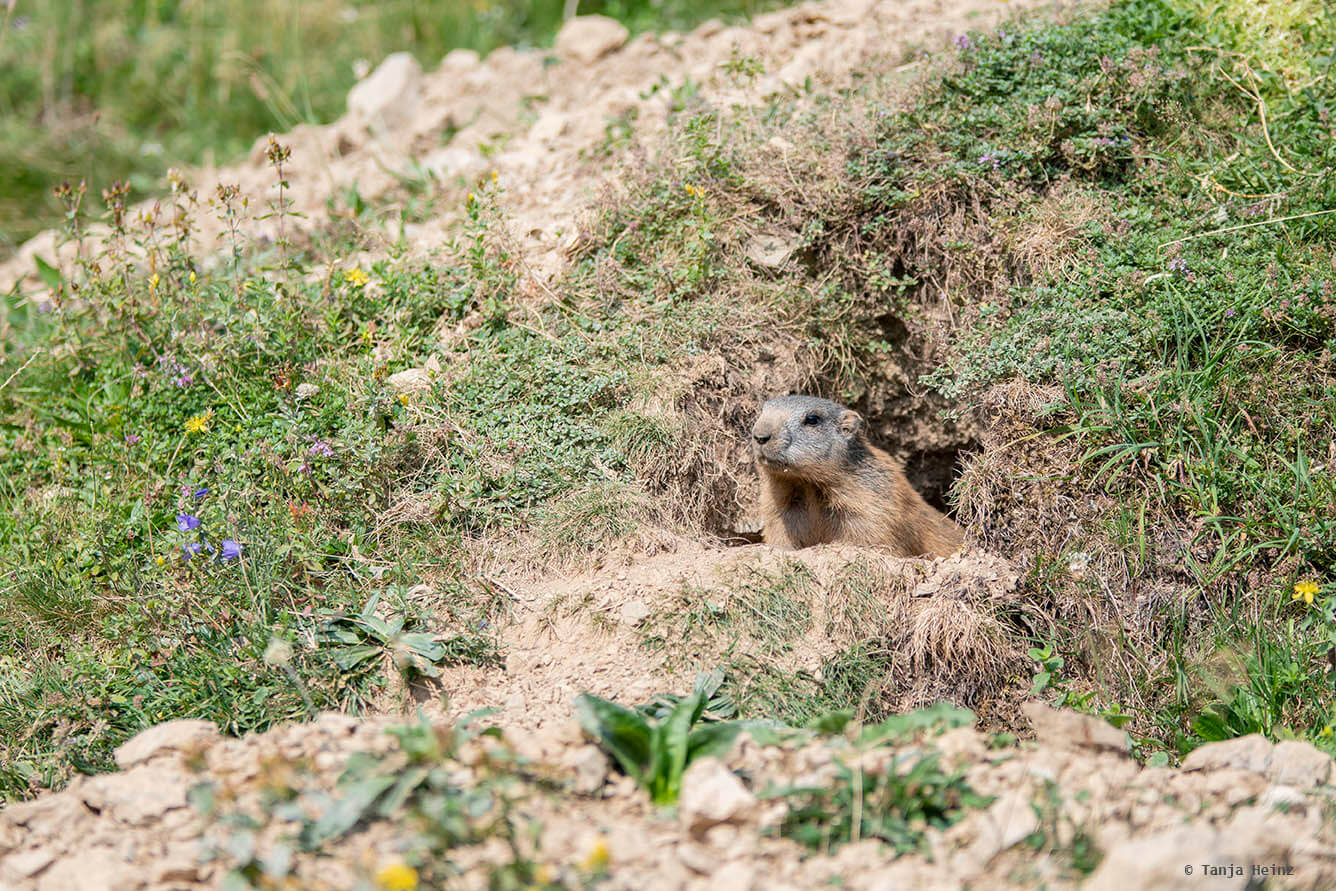
One individual was even so relaxed (at least it looked like this) and remained seated anywhere in the meadow.

Nevertheless, as I had spent some hours around the alpine marmots, I decided to leave at around 11 a.m., although the alpine marmots were still active and outside. I headed back and hiked down to Berchtesgaden again.
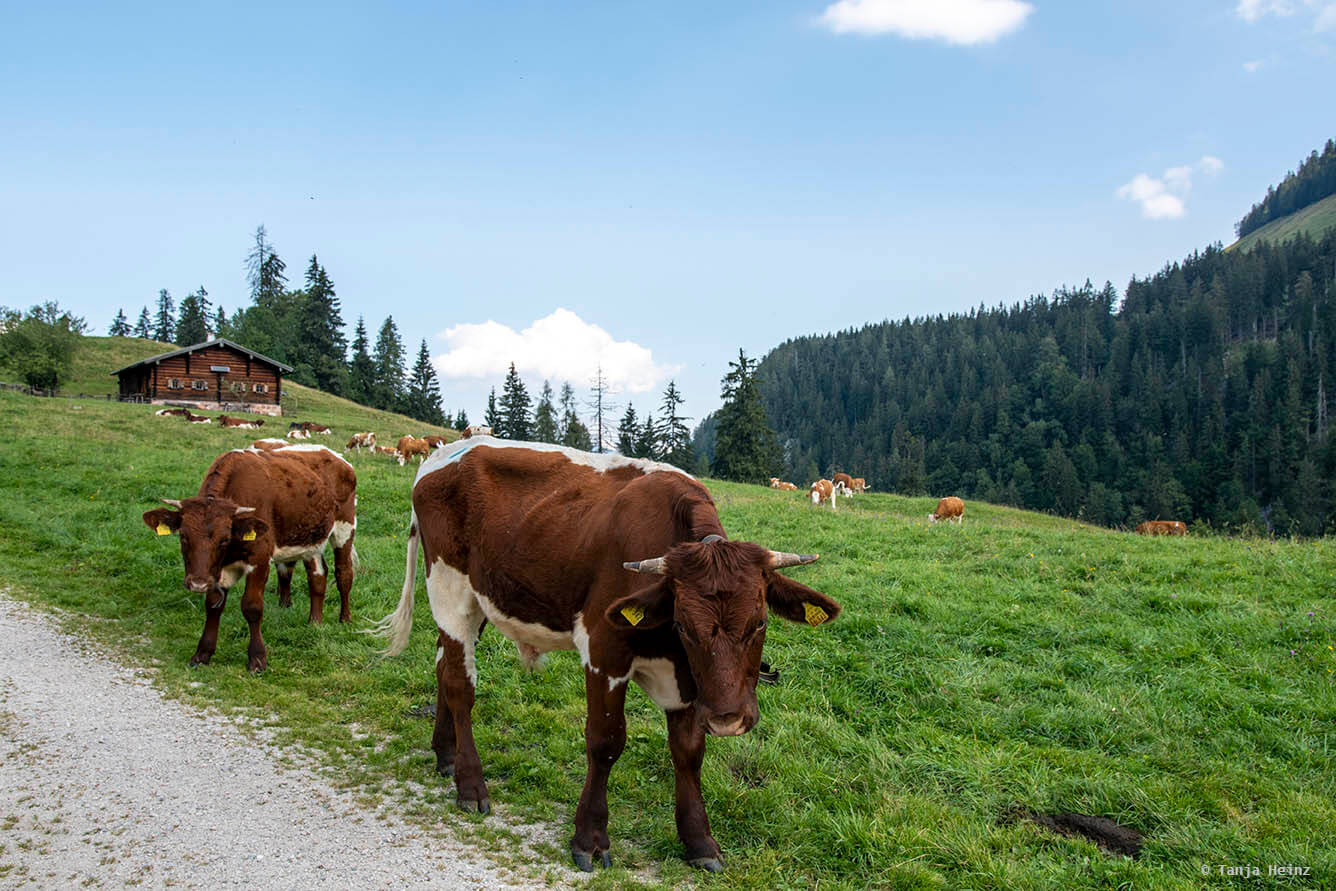
Tip: If you do not want to hike down, you can also take the Jennerbahn. You need to hike about 4 or 5 kilometers (depending on the path you take) to the gondola lift. There are many informative signs which will help you to find the right path.
A species portrait: alpine marmots
Marmots are rodents of the squirrel family (Sciuridae). Other animals that belong to the squirrel family are Eurasian red squirrels (Sciurus vulgaris) or Guianan squirrels (Sciurus aestuans). Marmots are relatively widespread ground squirrels and occur both in Asia and Europa, but also in North America. In total, there are about 15 different marmot species. The alpine marmot (Marmota marmota) is one of them.

Alpine marmots reach a size of between 43 and 73 cm on average (without the tail) and they can weigh up to 8 kilograms. But as they are hibernating animals, alpine marmots are lighter directly after hibernation in spring than in autumn. Their fur color is typically brownish and grayish.
Interesting: Did you know that most fingers of alpine marmots have claws, but their thumbs have nails? Claws and nails are made of the same substance - keratin - but while claws are curved and pointed, nails are thin plates.
Alpine marmots prefer mountainous areas. Thus, they live on meadows at high altitude in the Alps. They are distributed in Central and South Europe.

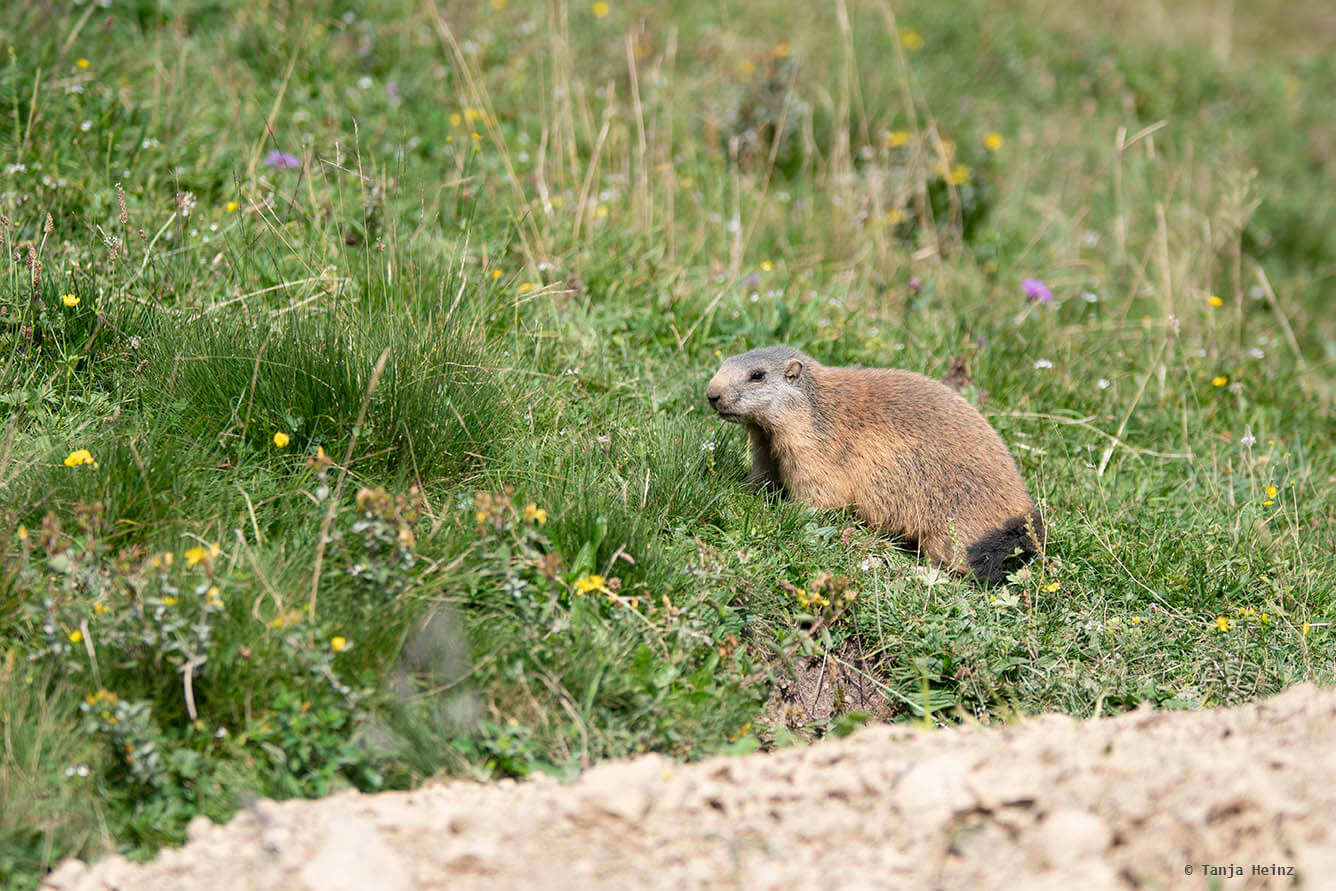
Alpine marmots live in a deep burrow system.
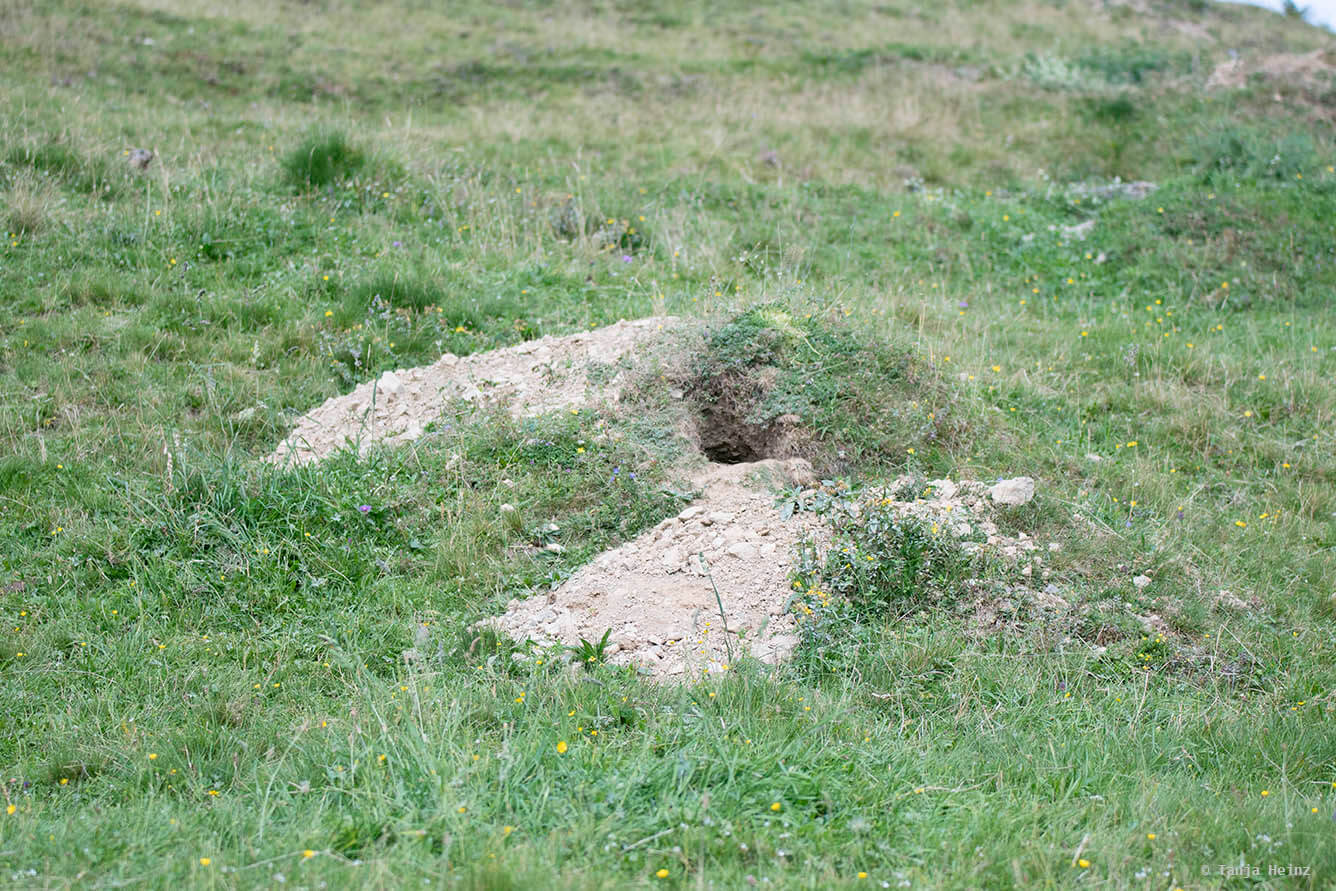
In one burrow system typically lives on family group with one dominant breeding pair, offspring of the year and young of the previous year. They spend most of their time in their burrows, including in winter during hibernation.
They are territorial animals and defend their burrows against intruders.
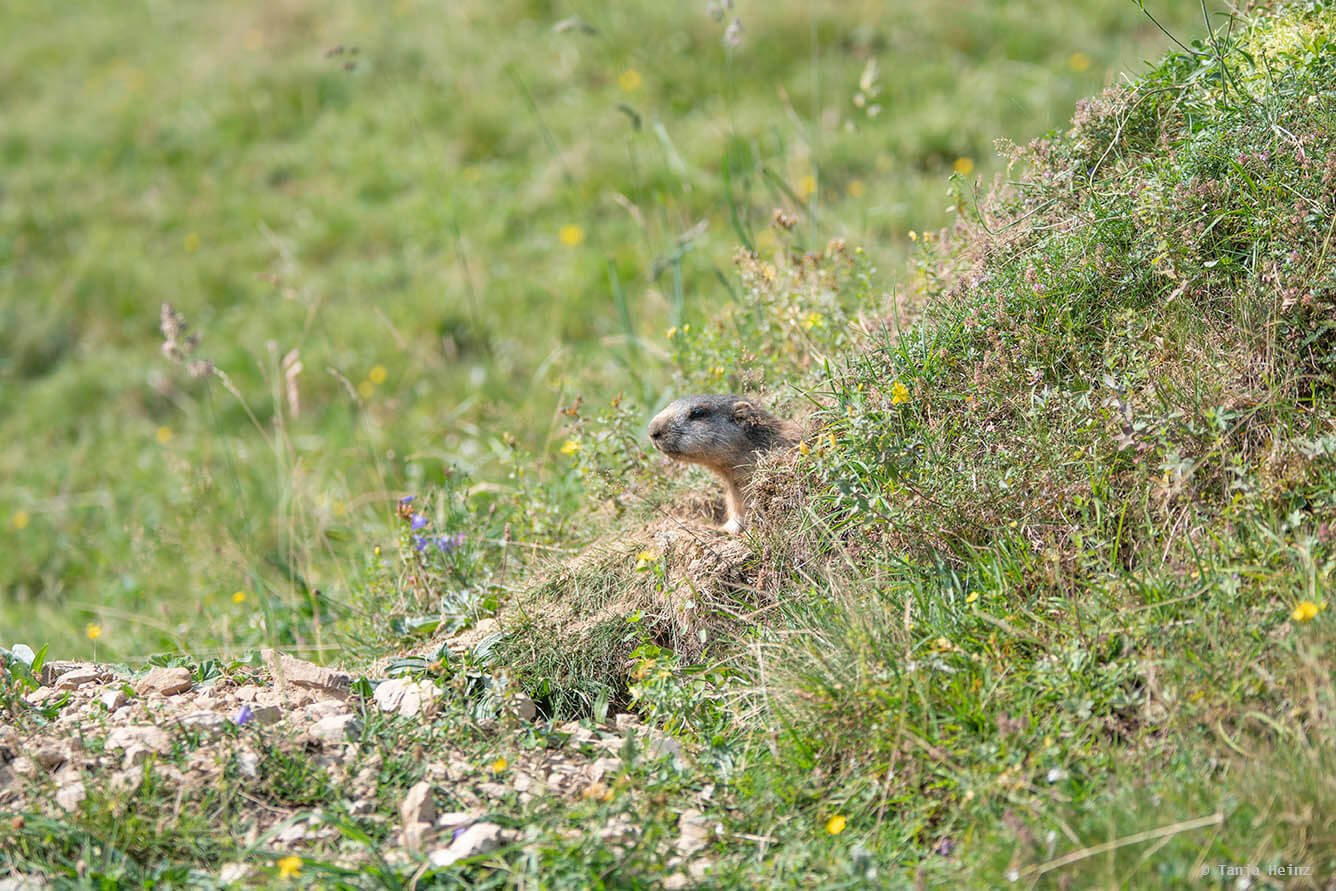
Interesting: Did you know that a dominant female prevents other females from breeding successfully? Although all females in a family group might be capable of reproduction, a dominant female might show antagonistic behavior towards other females in the group to cause stress, and thus, preventing them to reproduce.
Hibernation takes usually from October to the following March. During hibernation alpine marmots decrease their heart rates and their body temperature in order to save energy. They solely rely on their stored fat supplies during these winter months.
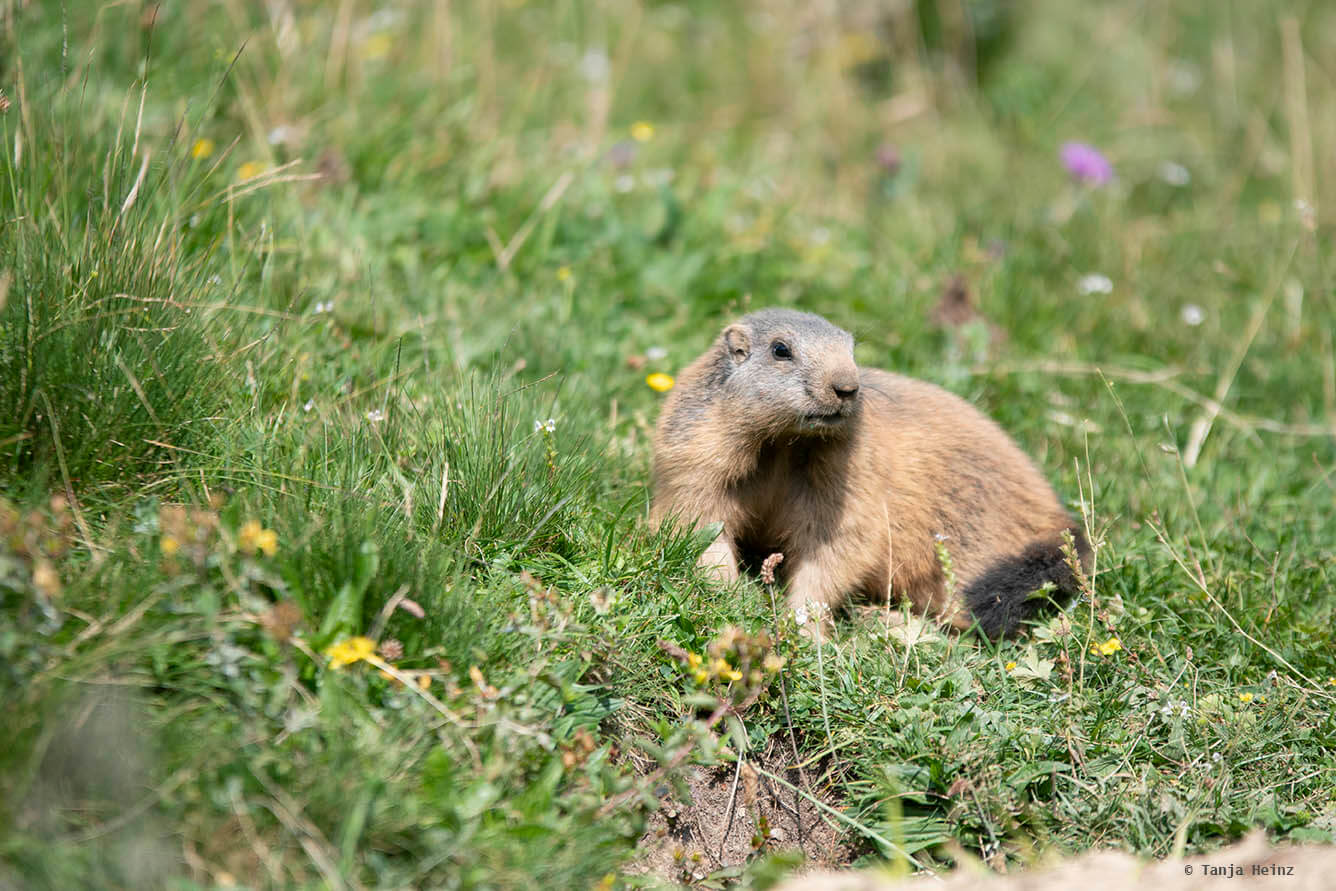
Immediately after hibernation the mating season starts. Mating season takes about two weeks. After a gestation of about 34 days females give birth to 4 young on average. Offspring are weaned at the end of June or beginning of July. Until October they have to create a fat layer before going into hibernation. The mortality among these young alpine marmots is especially high, as they do not have so much time to create a thick fat layer for hibernation like adult individuals.
Alpine marmots are temperature sensitive and a "sunbathing" animal probably is rather cooling down. However, this behavior might also be a strategy to get rid of parasites.
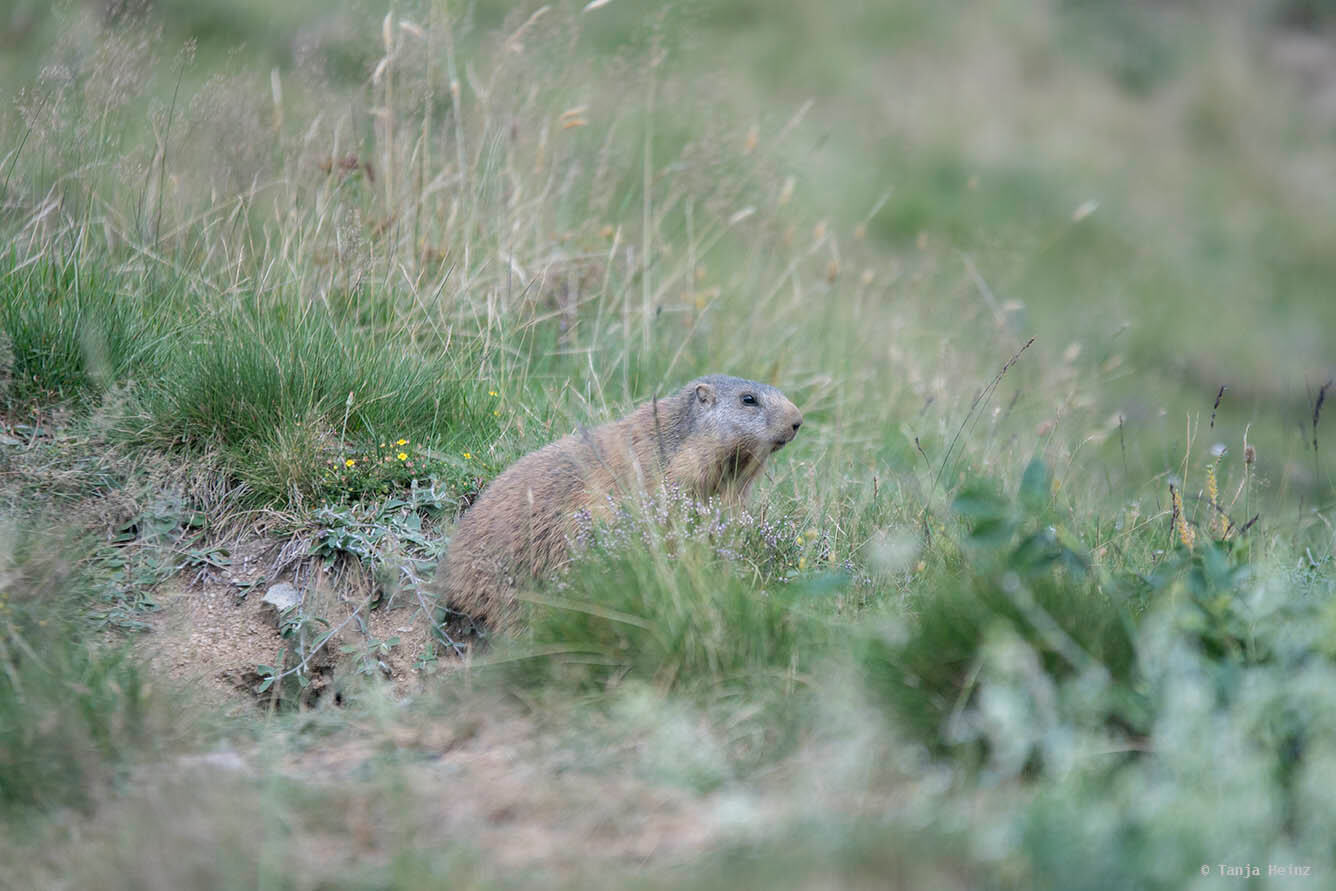
Alpine marmots are omnivores. They both feed on plants like grasses and herbs, but also on insects, spiders or worms. On a very warm day they might not eat at all, as it is too warm for them. But on the other hand, on a cool day they might eat even more in order to thicken their fat layers.
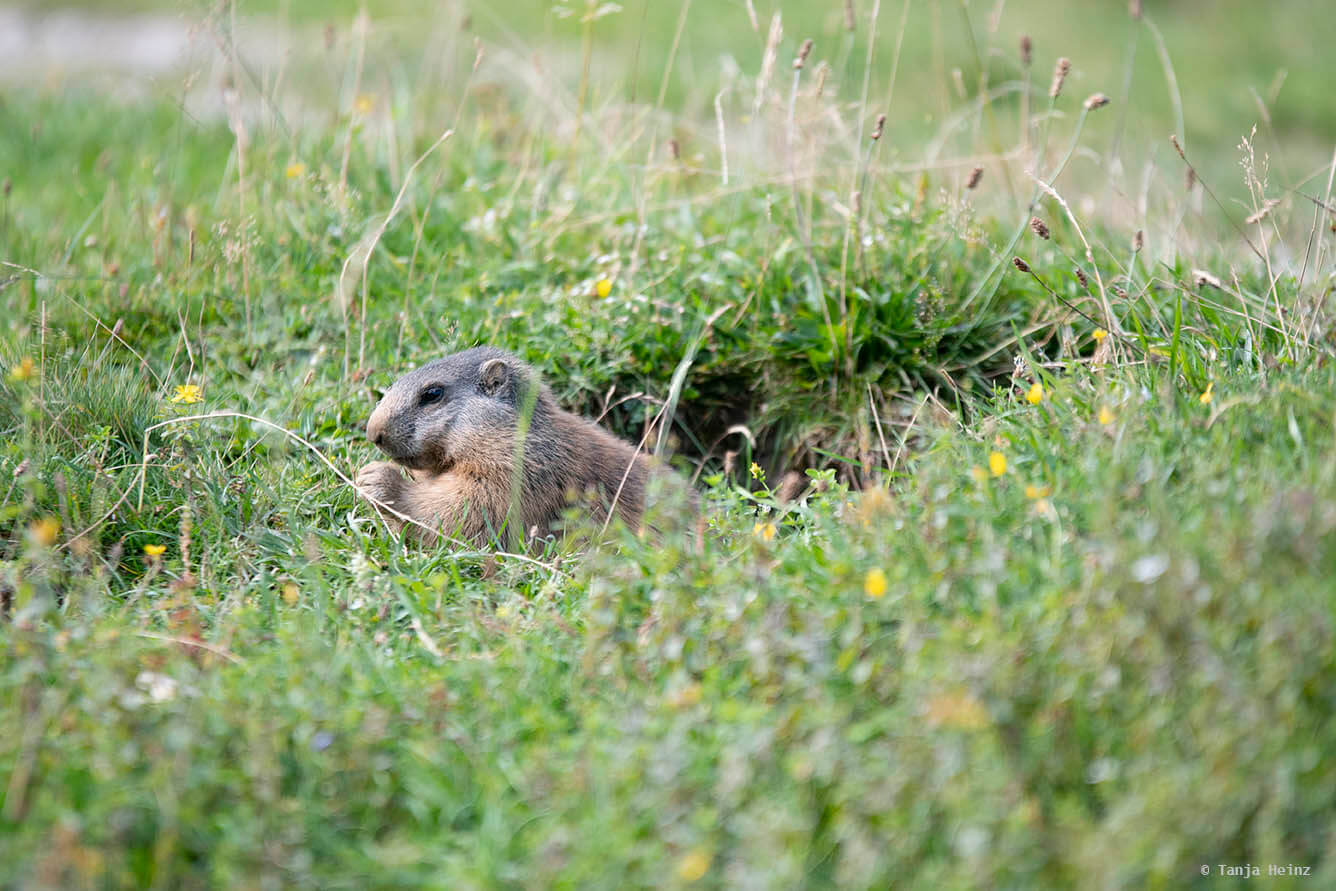
There is no sexual dimorphism like in grey seals among alpine marmot. Meaning that there are no obvious differences in the appearance between males and females.
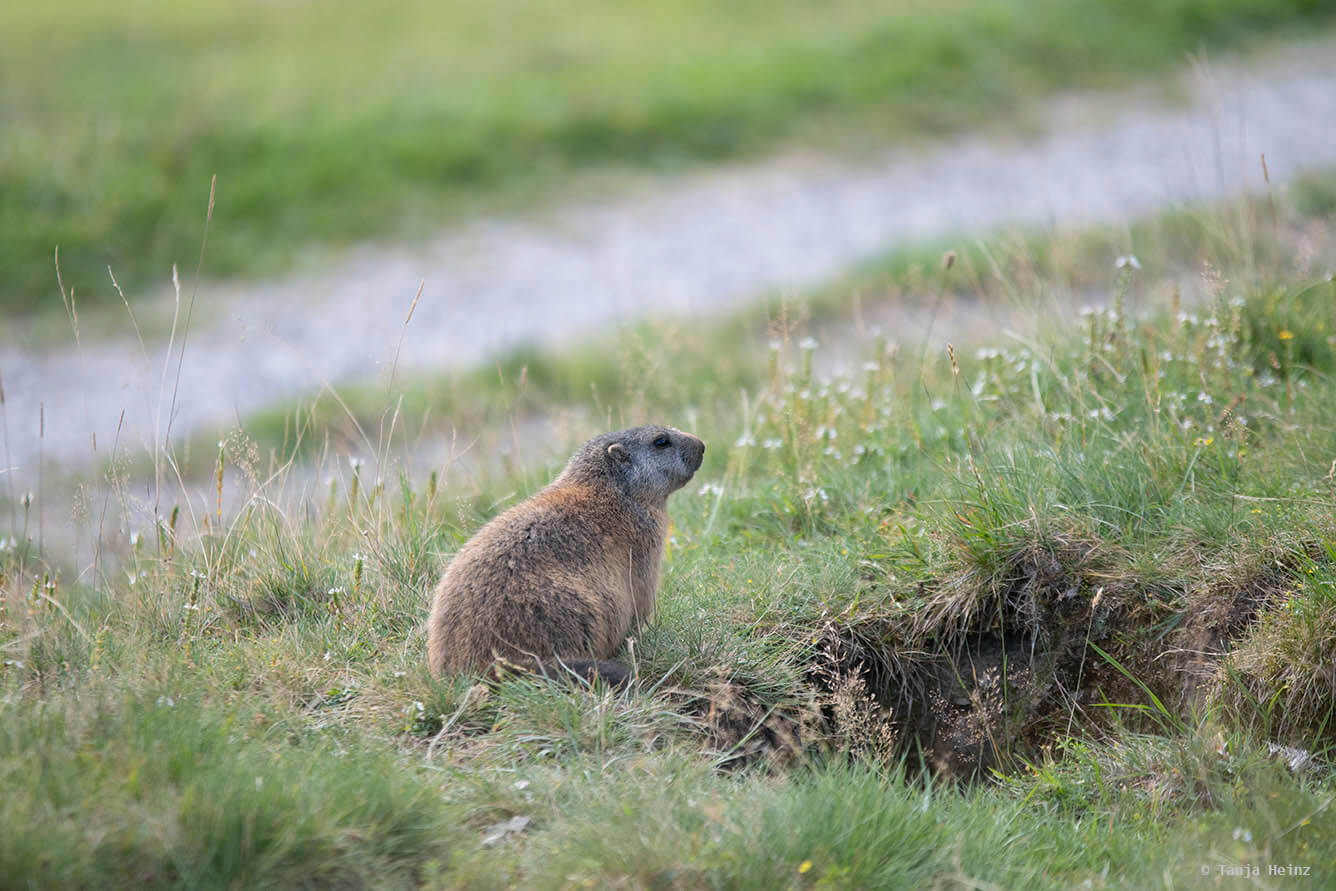
As burrow-dwelling rodents, alpine marmots can easily hide from their predators or visitors like me, respectively.
I still do not have any explanation why the alpine marmots behaved like this on that day. I don’t know why the marmots did not come out early in the morning. It was a hot day. At the beginning I thought, maybe the day was already too hot for them even in the morning. But why did they come out at around 10 a.m.? I also considered my presence to be the cause for their absence. On the other hand, they wouldn’t have come out later, neither. Or maybe there was a predator around early in the morning and they hid from it? I don't know, but this might be another reasonable explanation. One of their main predators are golden eagles (Aquila chrysaetos).
Nevertheless, I was happy that some alpine marmots ventured outside their burrows.
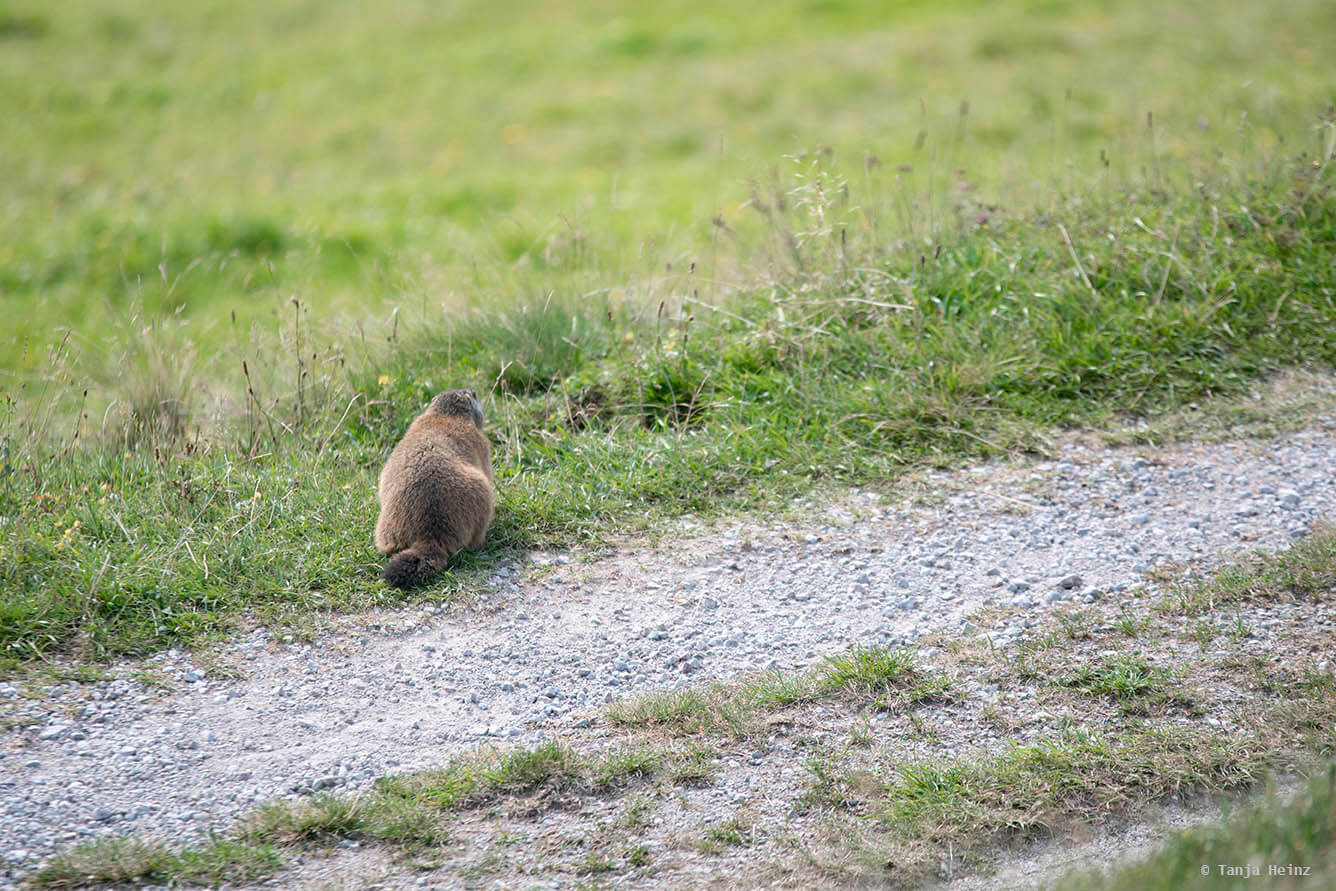
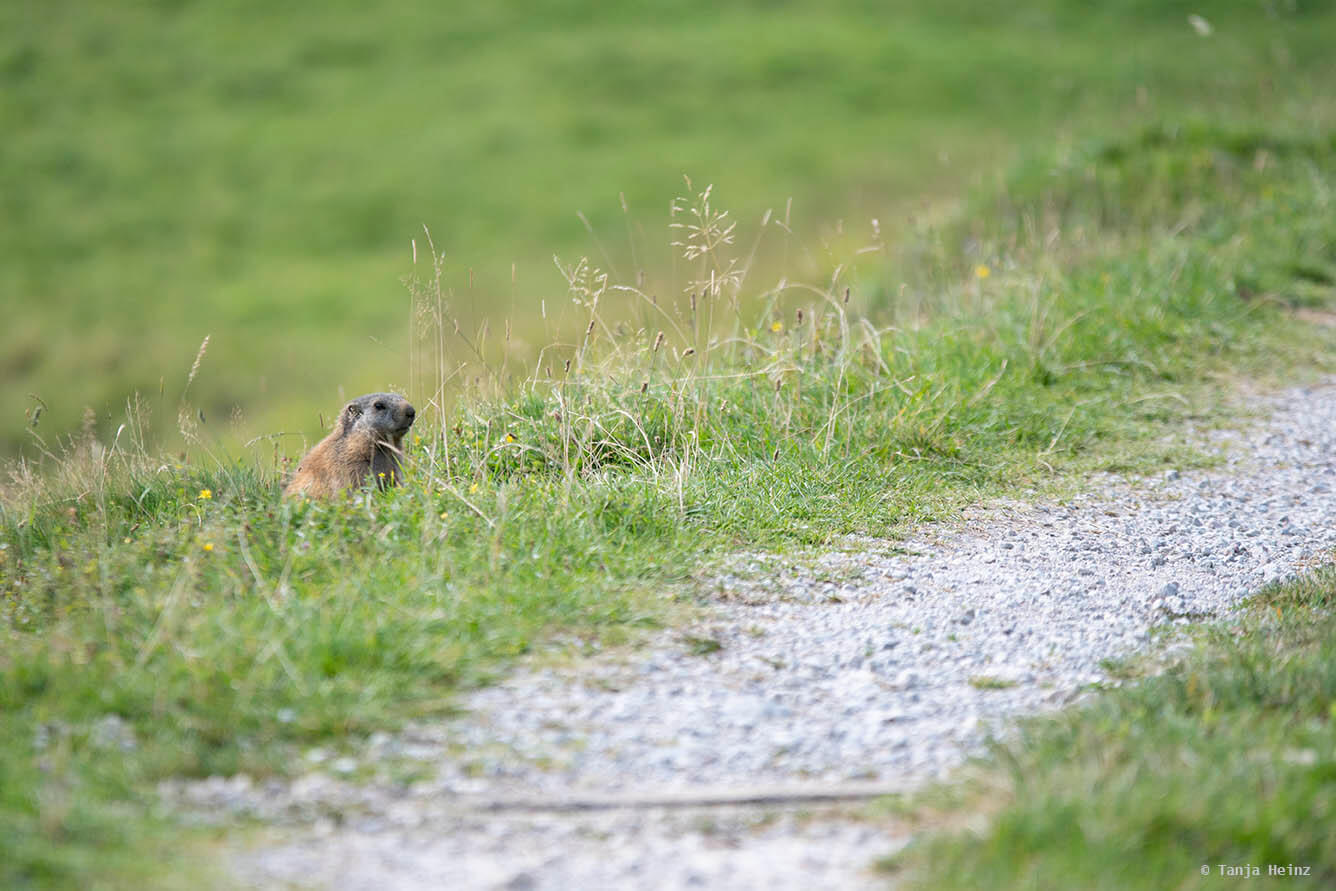
Or looking outside.

I don’t know how busy it was later on that day, but on that morning I was almost all by myself on that hill (except the man who helped me and the farmer around the alp).
By the way, according to the IUCN alpine marmots are listed in the category of "Least concern" and their population seems to be stable. Let’s hope all the best for alpine marmots, especially in times of global warming.
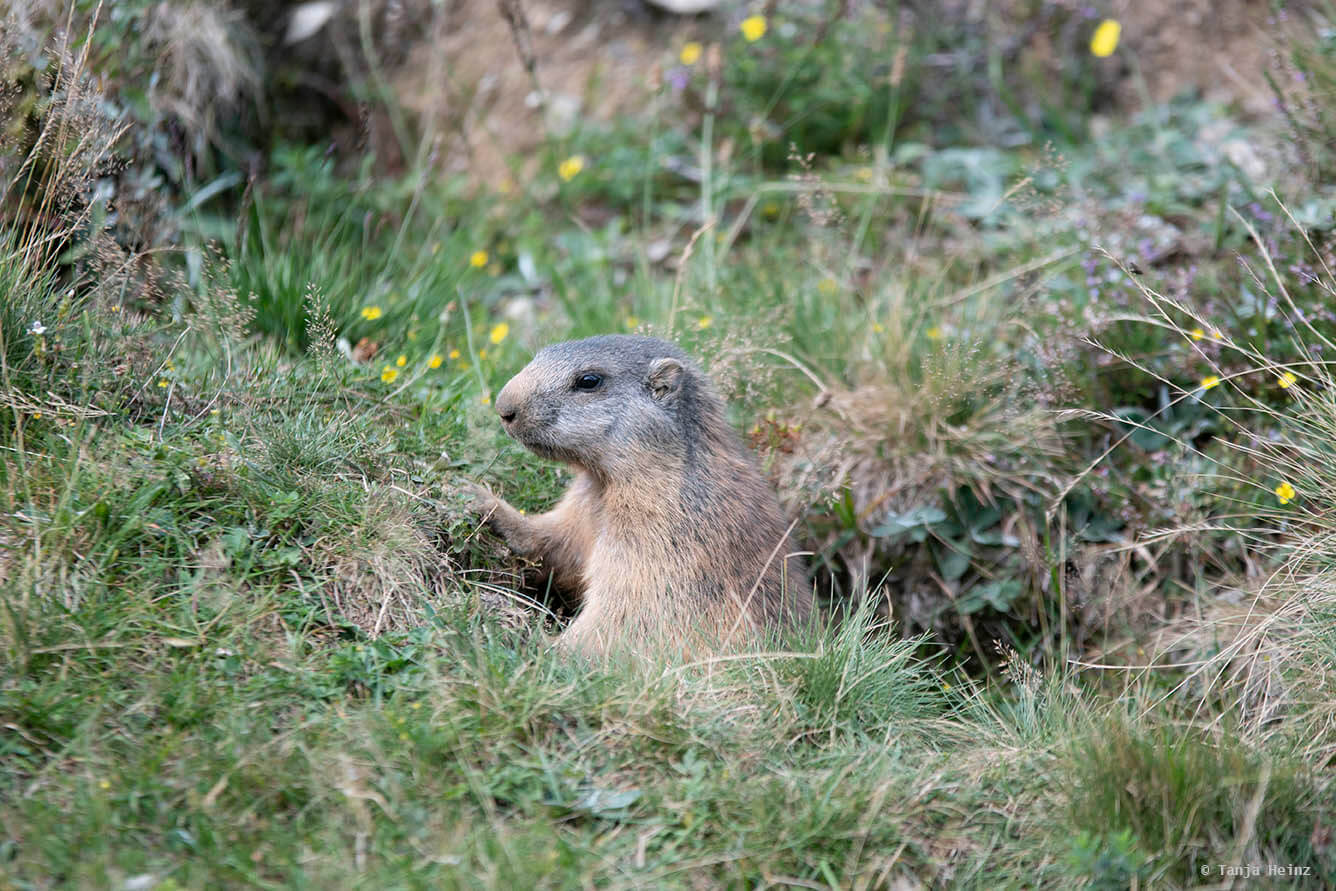
Interesting: Most marmot species are listed as "Least concern" by the IUCN. However, Menzbier’s marmots (Marmota menzbieri) and Mongolian marmots (Marmota sibirica) from central Asia are listed in the category "vulnerable" and "endangered", respectively. Vancouver Island marmots (Marmota vancouverensis) from western Canada are even "critically endangered" according to the IUCN.
Walking tour to the Königsbachalm
The hike from the Jennerbahn up to the Königsbachalm was tough, as I was walking quite rapidly through the darkness. Luckily, there were many signs which helped me to find the path to the Königsbachalm. Although it was dark, I did not get lost.
The landscapes around the Jennerbahn are very beautiful. However, if you start like me in the night you have to wait and marvel at them only on the way back.
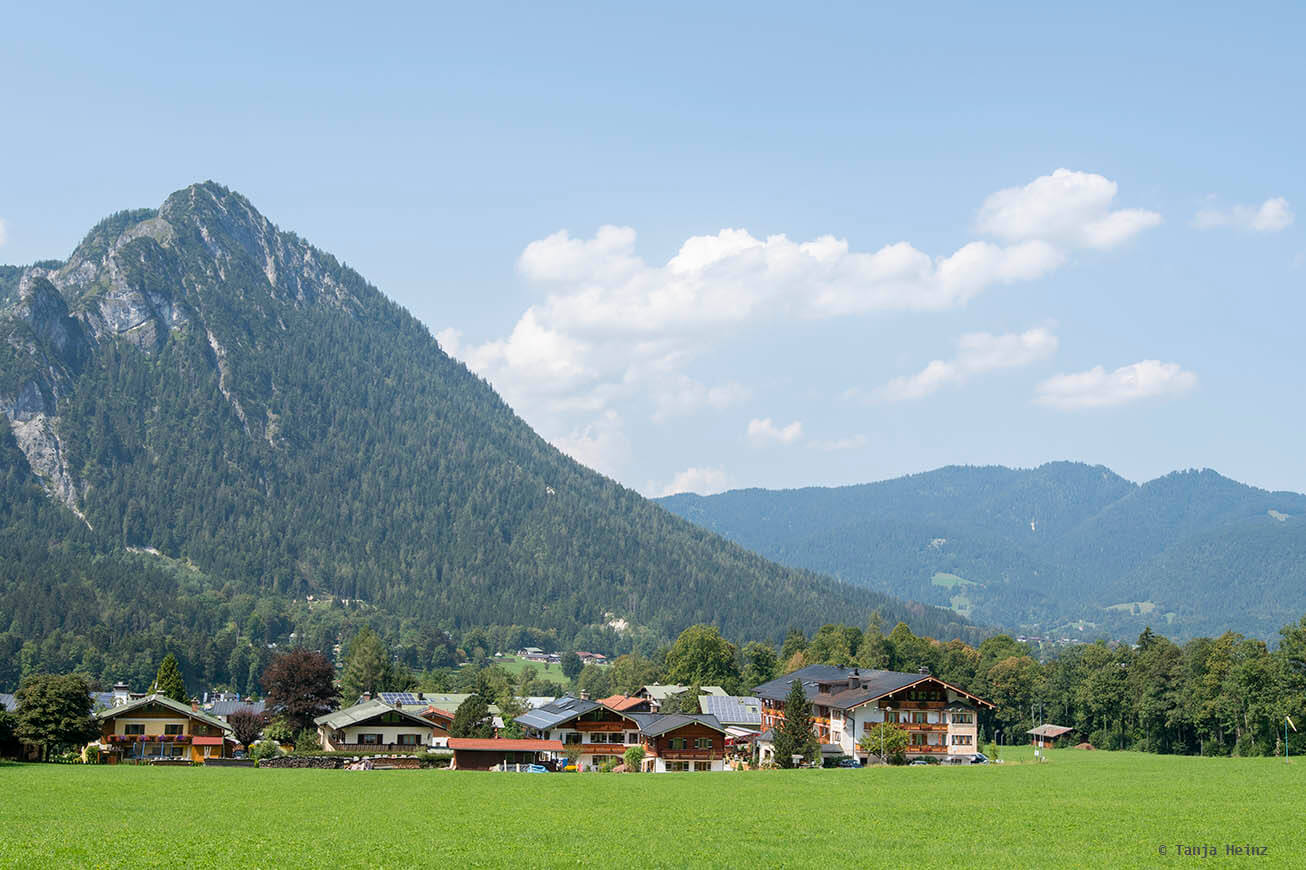
The path up the mountain can be partly quite steep, and thus, kind of exhausting. On a hot day I definitely recommend to hike up the mountain early in the morning. When I wandered back down to the Jennerbahn, I encountered quite many hikers with red and sweaty faces. It was really a very hot day, although in the morning it can be quite cool up in the mountain.

I also observed quite many cyclists. I’m sure that this was also a quite tough exercise.
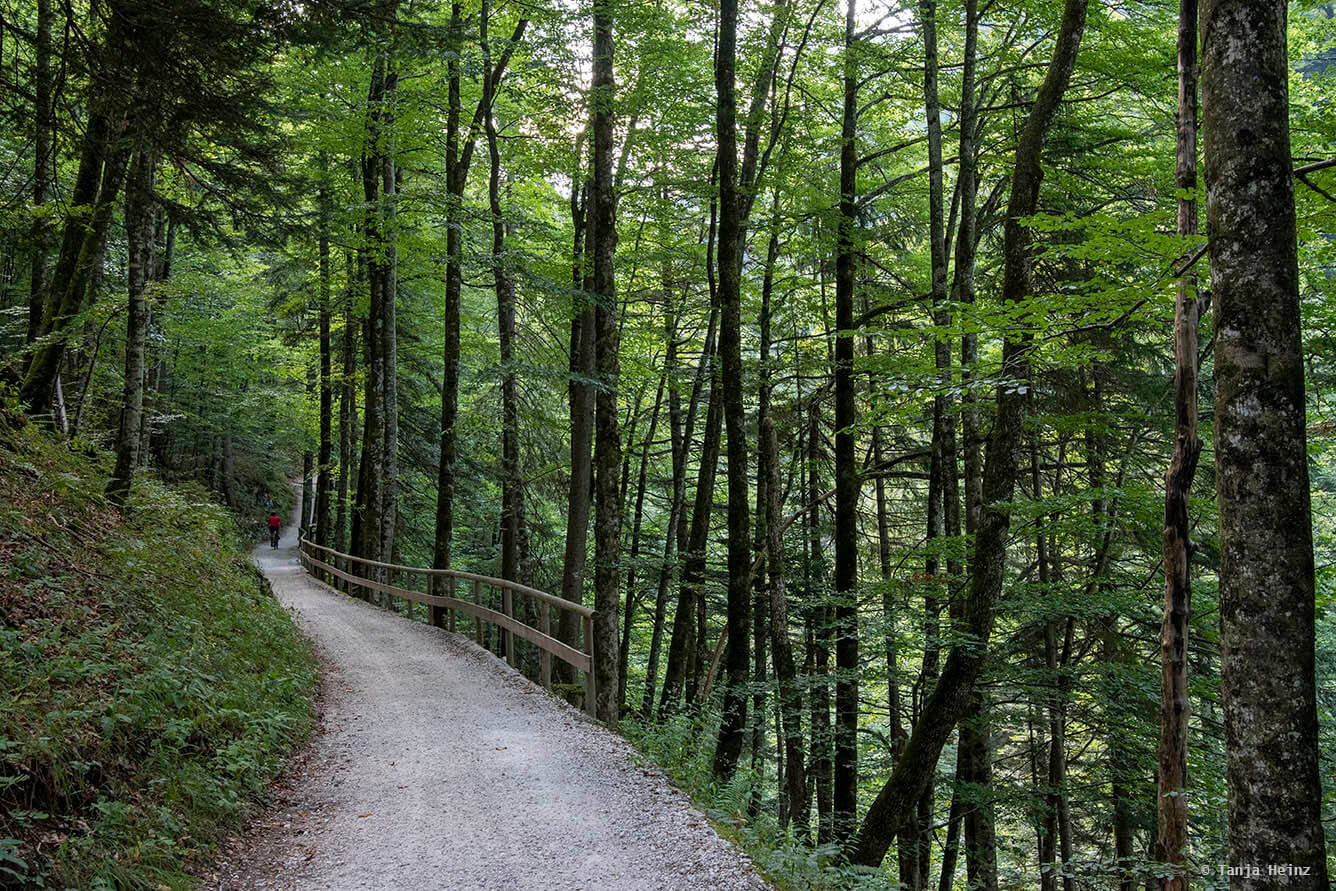
Nevertheless, during the day you will get some very spectacular views onto the Königssee! Just wow!

Close to the Königsbachalm you will get more wonderful views onto the mountains.

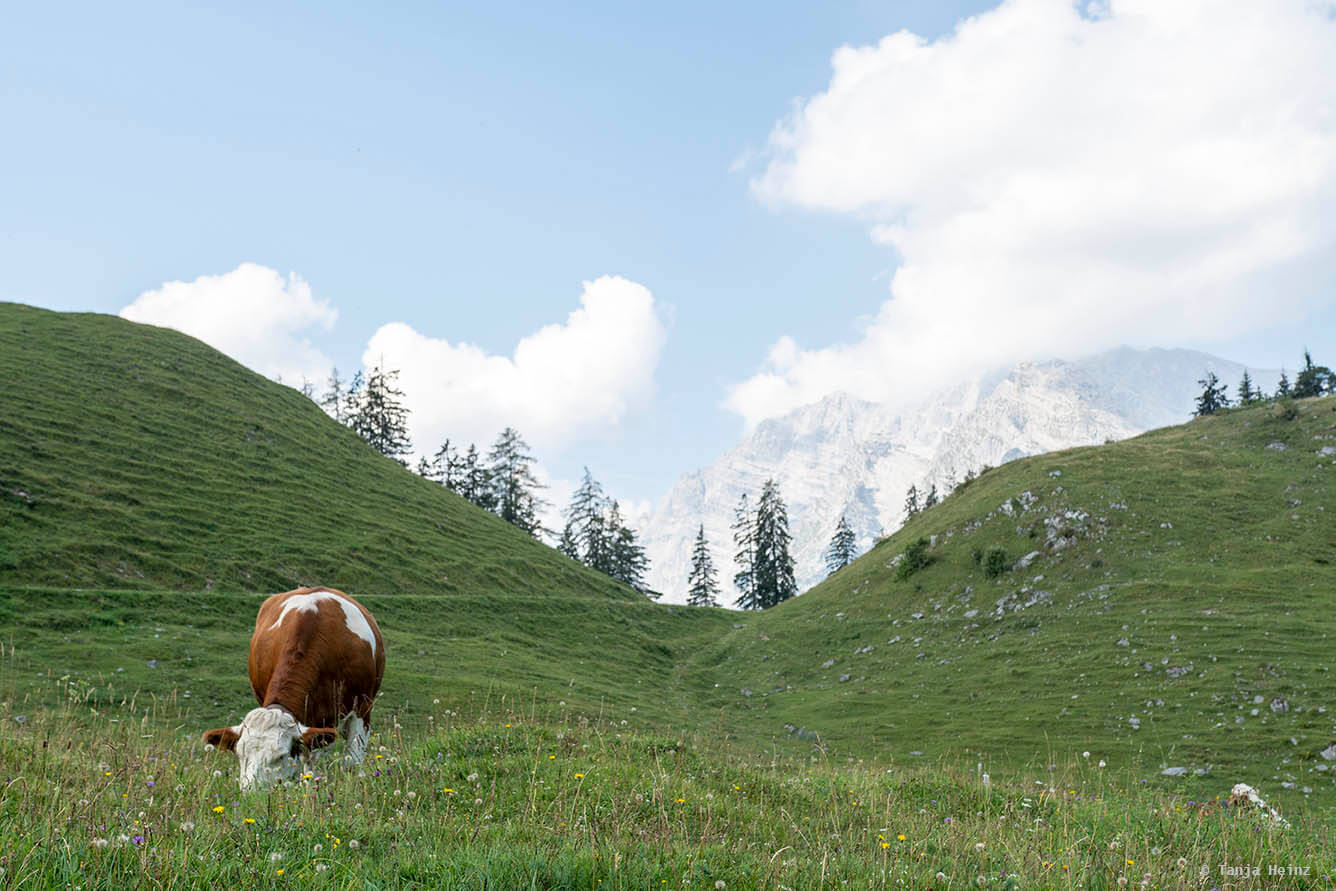
At the end, for me it was the right decision to leave early in the morning. Yes, the alpine marmots became more active later on the day - for any reason I do not know - but this might not be the case on another day! This way I increased my chances to observe them. If you want to watch wildlife, you never know what happens. When will the animals emerge? Will they emerge at all? And how will they behave? All that will be a surprise to which you have to adapt to...
Practical information for Berchtesgaden
How to get there
I took the train to the train station in Salzburg and from there I had to take bus number 840 to Berchtesgaden. The journey from Salzburg to Berchtesgaden took less than one hour and the bus stopped at the train station in Berchtesgaden. I paid 29,90 Euros for one ticket from the Allgäu to Berchtesgaden. On my way back I could use the train from Berchtesgaden to the Allgäu. With 25,00 Euros the ticket was a little bit cheaper on my way back. Try to check the website of the Deutsche Bahn regularly in order to get one of the discount tickets (German: "Sparticket"). If you visit the official website of Berchtesgaden, you will get more information about other arrival possibilities.
Where to stay
I stayed at the youth hostel Berchtesgaden (German: "Jugendherberge Berchtesgaden"). The hostel is located in the street Struberberg 6, 83483 Berchtesgaden. It was a very nice hostel where many families with their children spent their holidays. Thus, it was also a very lively atmosphere in the youth hostel on those summer days in August. I spent two nights in the hostel and paid 55,00 Euros for two nights in a dorm. Breakfast was included. You can also check their official website to get more information.
Moving around
If you do not have a car, you can also move around by bus. I took bus number 839 from the train station in Berchtesgaden to the youth hostel. Please check the website of the Oberbayernbus to get more information about the timetable. On the official website of the youth hostel you will get more information about how to get to the youth hostel and moving around in Berchtesgaden.
More information and resources
More information about the Berchtesgadener Land:
Official website of Berchtesgaden
Website about the Königsbachalm (only in German)
More about the Königsbachalm (only in German)
Animals in the national park Berchtesgaden (only in German)
Official website of the Jennerbahn (only in German)
More information about alpine marmots:
Alpine marmots in the Allgäu Alps
Alpine marmots around the Grossglockner
Blog article about alpine marmots in the Berchtesgadener Land (only in German)
Deutschlands Natur: resources about alpine marmots (only in German)
Alpine marmots on Wikipedia
Habitat preferences of alpine marmots - Marmota marmota by Dominique Allainé et al.
(doi: 10.1139/z94-293)
Reproductive suppresion in female Alpine marmots - Marmota marmota by Hackländer et al. (doi:10.1006/anbe.2003.2159)
Have you already been anywhere in the Berchtesgadener Land? And have you seen alpine marmots? Let me know in the comments.


